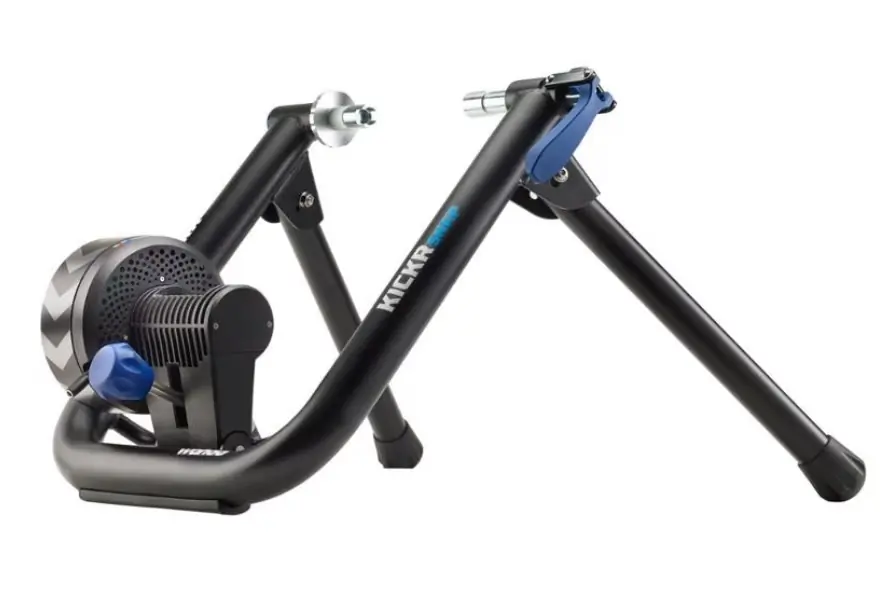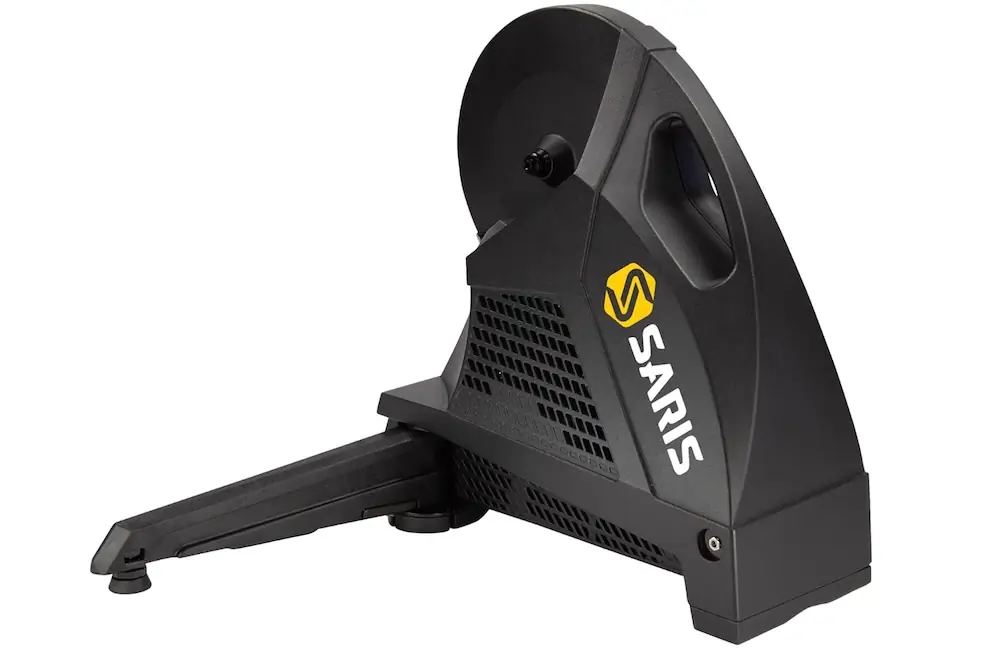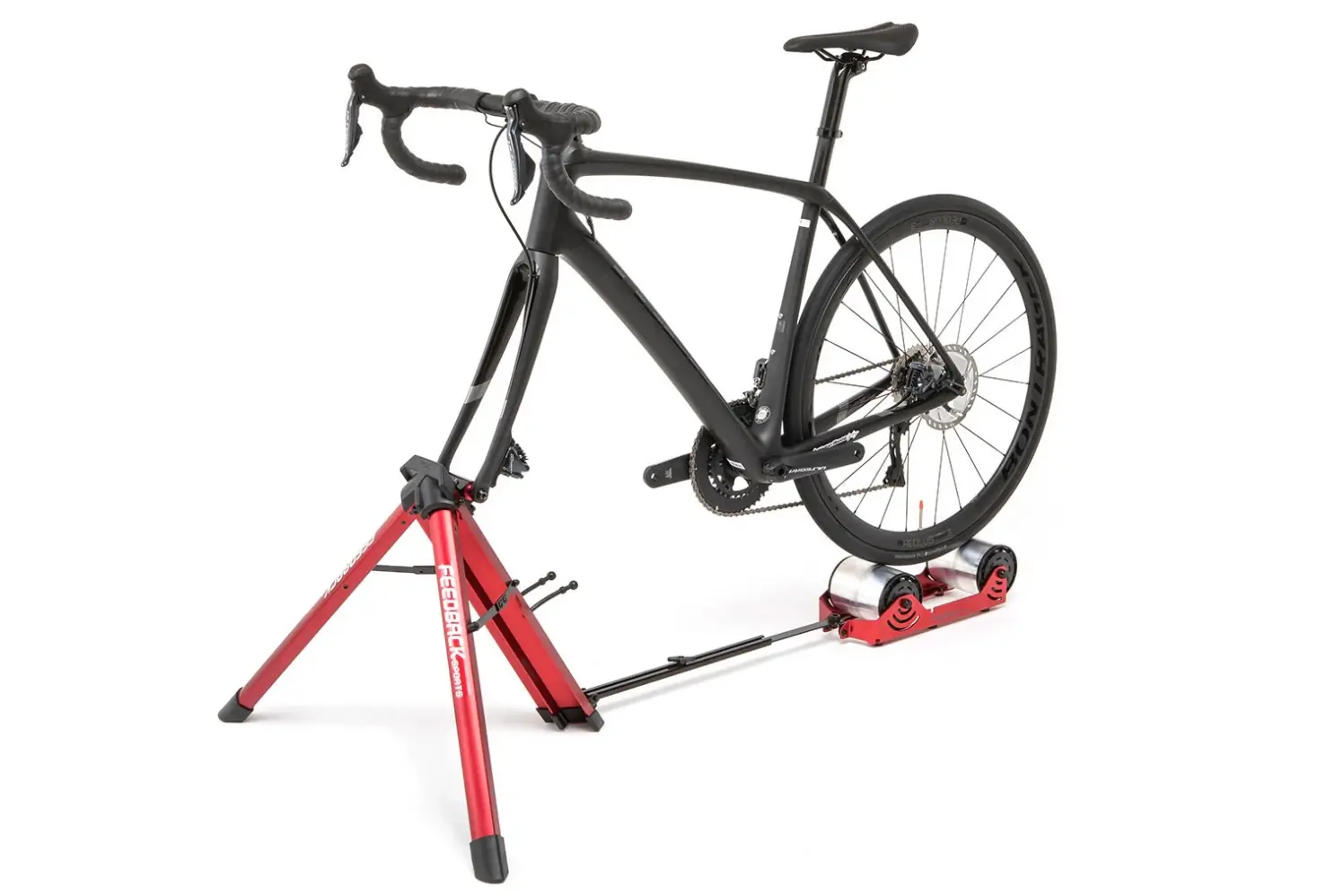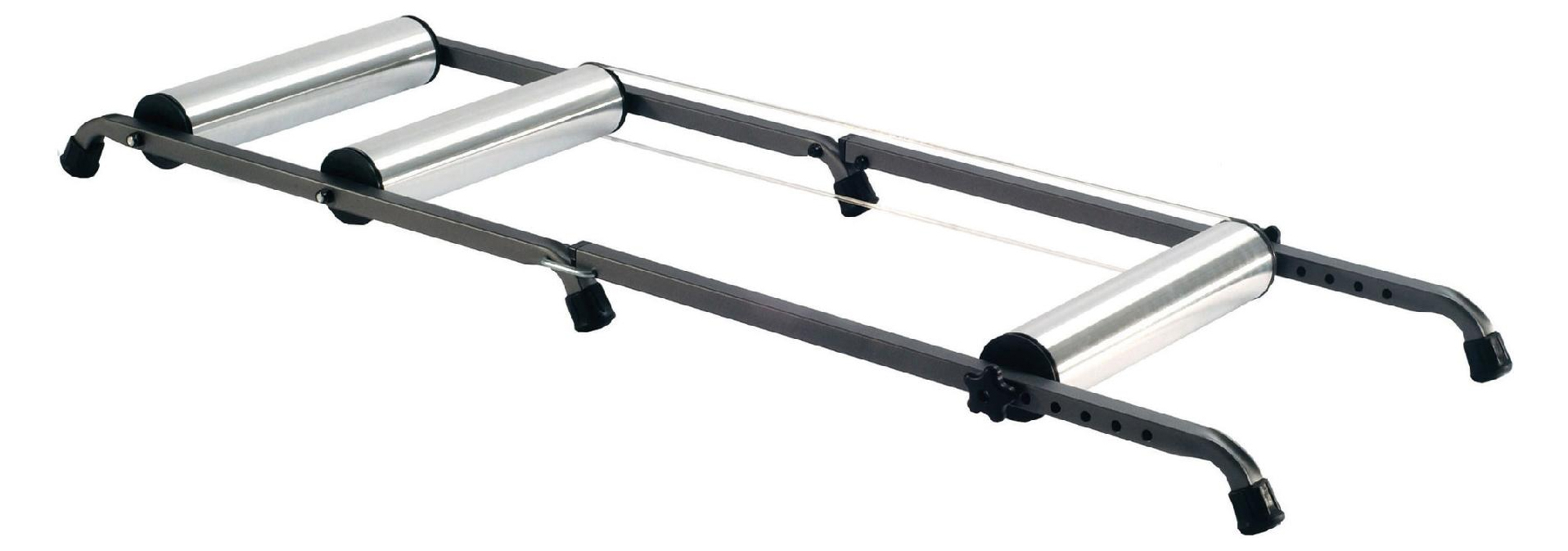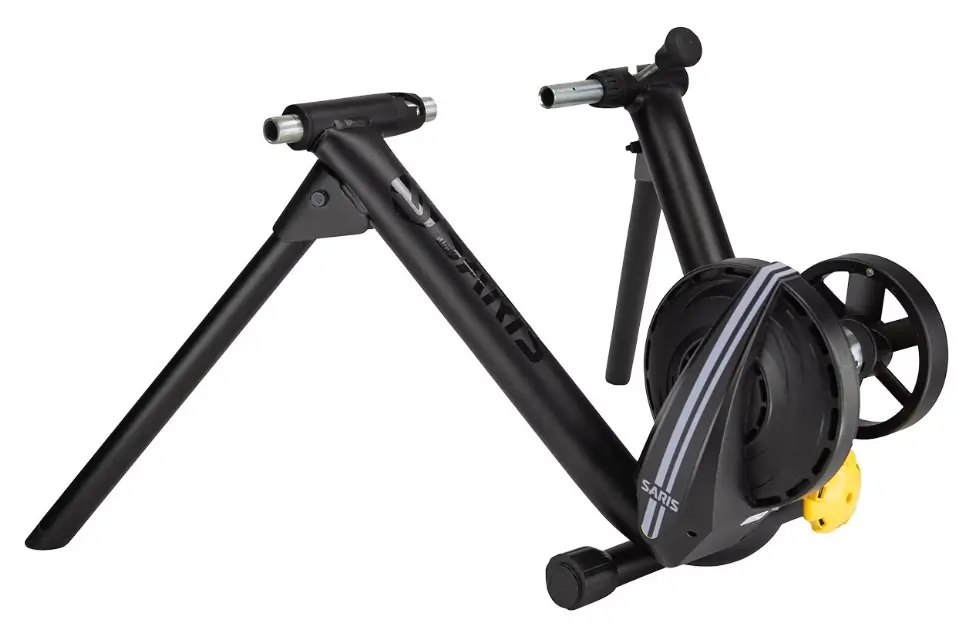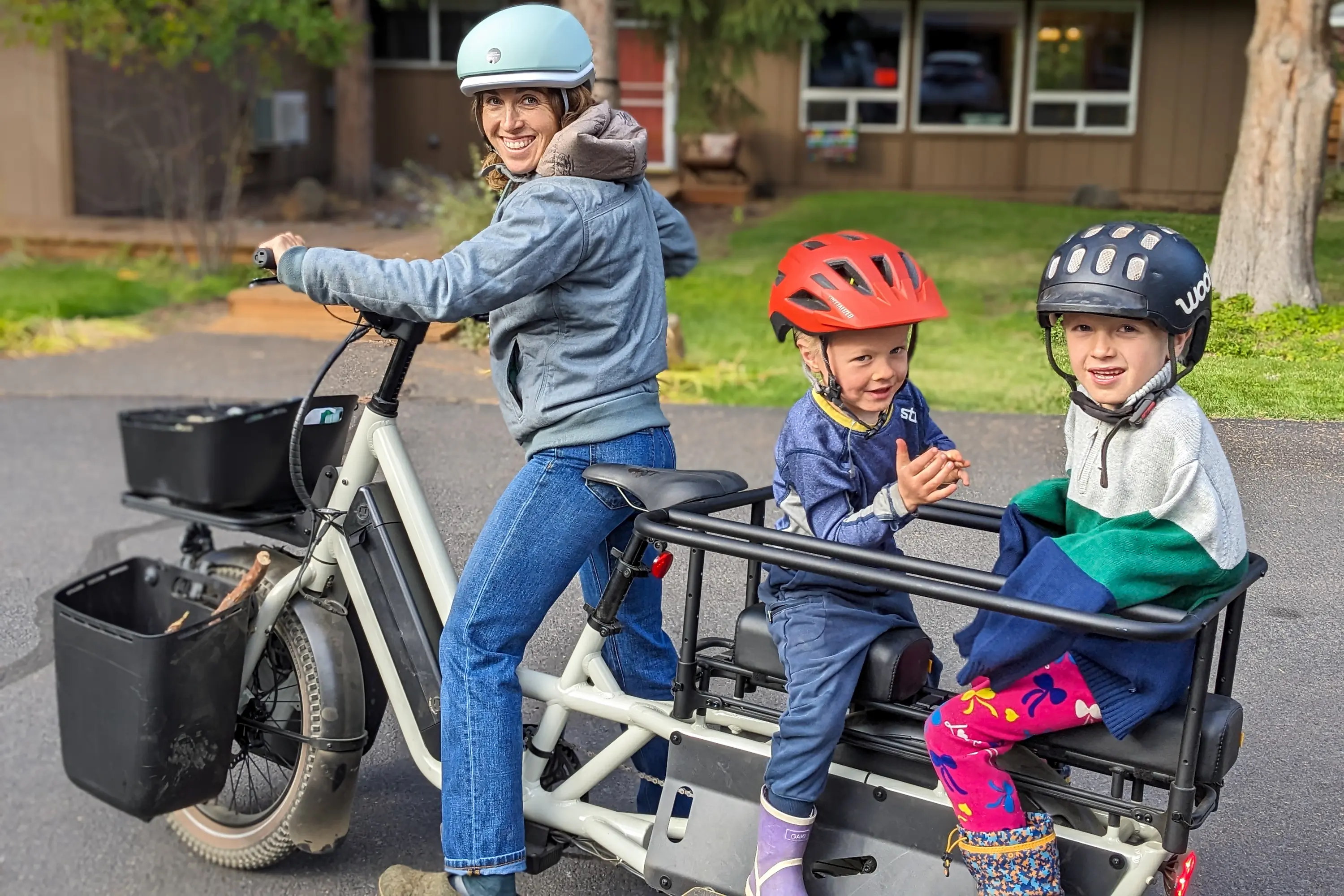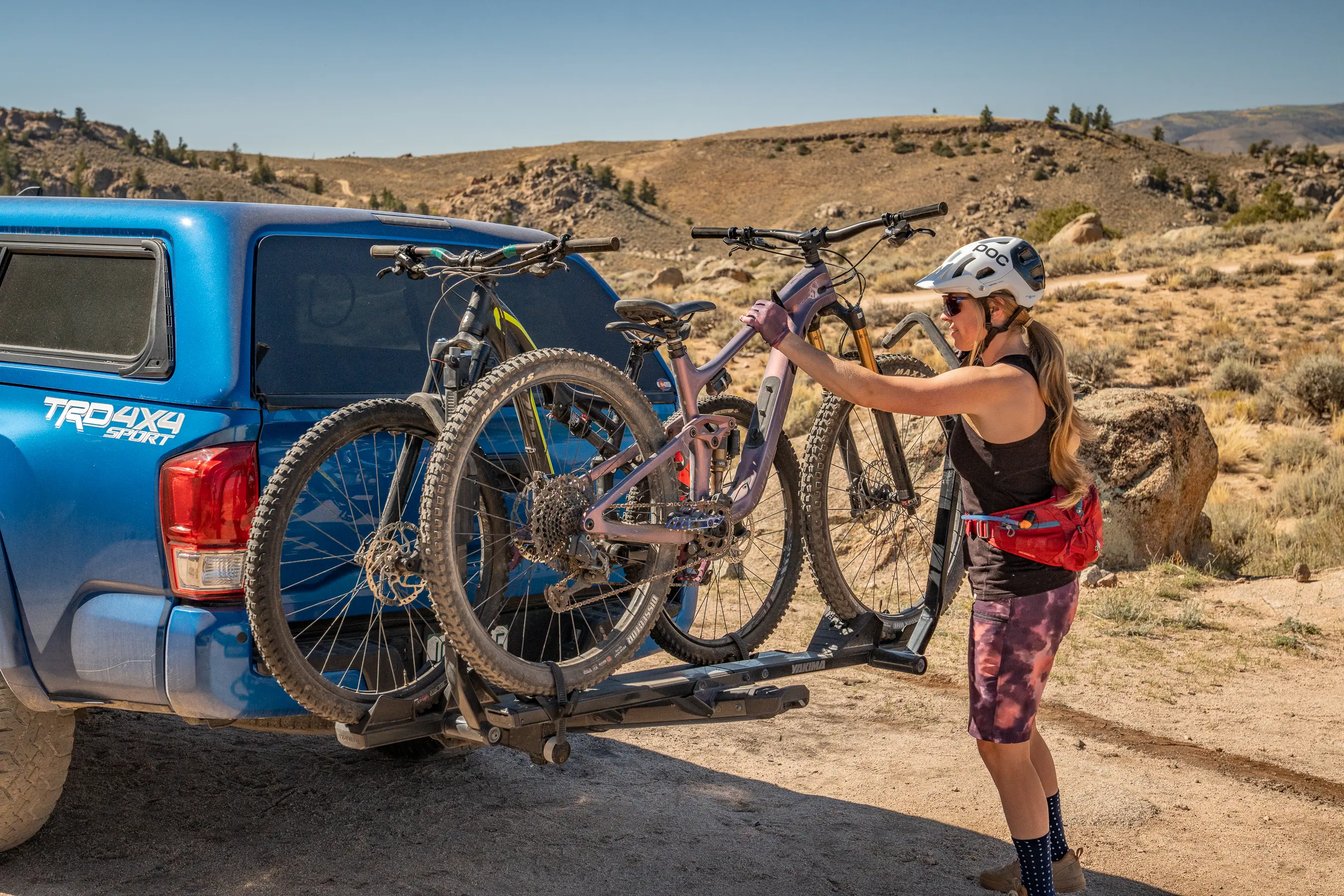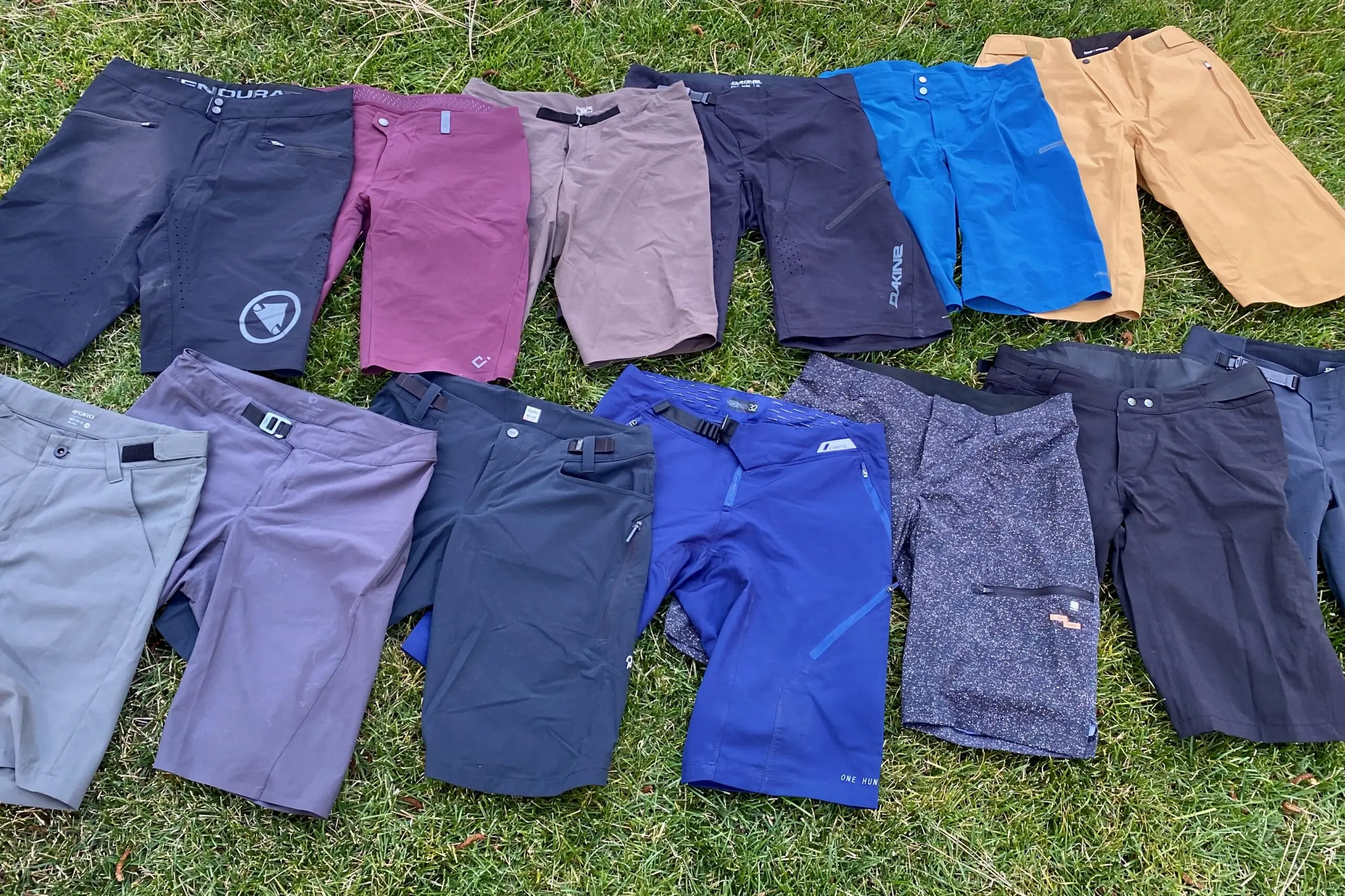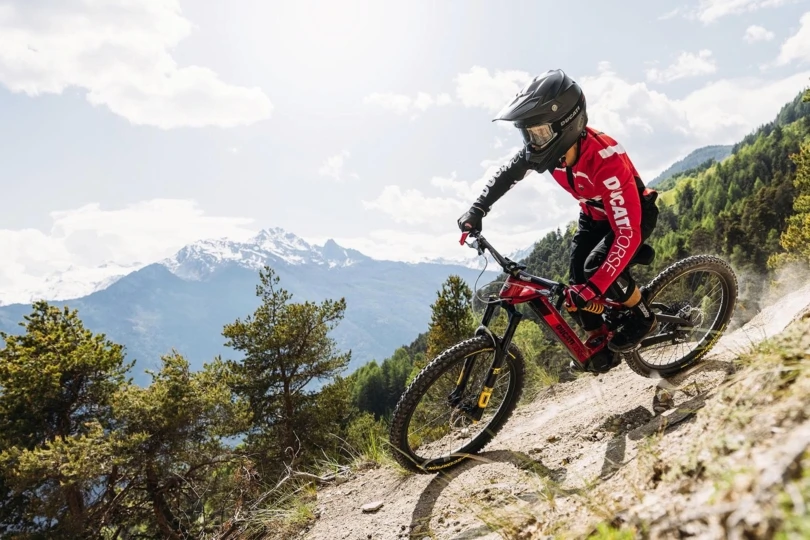While we’d almost always prefer to ride outside, sometimes it’s just not feasible. Limited daylight, inclement weather, and time commitments often conspire against us, so having the best bike trainer is a great way to maintain your fitness and stay on top of your training.
Love it or hate it, indoor training is a necessity for many serious cyclists in the fall, winter, and spring. For others, bike trainers can provide a level of control and efficiency that can be hard to replicate outdoors. Thankfully, there are more bike trainer options than ever before and more ways to maintain and improve your fitness from the comfort of your own home — or “pain cave.”
From high-end training tools like the Garmin TacX Neo 2T to the super-simple and affordable Alpcour Bike Trainer, we’ve got recommendations for all types of indoor riders and budgets. If you’re new to indoor bike training, our Ultimate Guide to Indoor Bike Training has all the info you need to get started.
Editor’s Note: We refreshed this guide for the fall and winter indoor riding season on October 15, 2024, with the addition of several recently tested models, including the affordable direct-drive Saris H3 Plus, the race warm-up ready Feedback Sports Omnium Overdrive, and the top-rated Garmin TacX Neo 2T.
The Best Bike Trainers of 2025
Garmin TacX Neo 2T
- Type: Direct-drive
- Smart: Yes
- Max. Resistance: 2,200 watts
- Accuracy: +/- 1%
- Weight: 47 lbs.
Pros
- Accurate power measurement
- Super quiet
- Stable
- Steel frame
- Simulated vibration
Cons
- Expensive
- No carry handle
- No cassette included
Wahoo Fitness KICKR SNAP
- Type: Wheel-on
- Smart: Yes
- Max. Resistance: 1,500 watts
- Accuracy: +/- 3%
- Weight: 38 lbs.
Pros
- Accurate power measurement for the cost
- Relatively affordable
- Competition-ready resistance
- Less involved setup compared to direct drive
Cons
- Price point too close to direct drive
- Need to use a trainer tire
- 142 mm thru-axles require purchase of an adapter
Saris H3 Plus
- Type: Direct-drive
- Smart: Yes
- Max. Resistance: 2,000 watts
- Accuracy: +/- 2%
- Weight: 48.3 lbs.
Pros
- Affordable for direct drive
- Relatively quiet
- Works great with Zwift and other apps
- Folds up relatively small
- Compatible with most axle sizes
Cons
- Need to purchase a cassette – or swap from your bike
- SRAM XD/XDR freehubs sold separately
Alpcour Bike Trainer Stand
- Type: Wheel-on
- Smart: No
- Max. Resistance: Not specified
- Accuracy: N/A
- Weight: 20.2 lbs.
Pros
- Price
- Portability
- Handlebar-mounted resistance control
Cons
- Very basic
- No app connectivity
- Louder than others on this list
Feedback Sports Omnium Over-Drive
- Type: Roller hybrid
- Smart: No
- Max. Resistance: n/a: Internal Progressive Resistance
- Accuracy: n/a
- Weight: 14 lbs.
Pros
- High quality build
- Extremely lightweight
- Simple to operate and store
- Portable – easy to take to races or when traveling
Cons
- No connected features
- 225 lbs. weight limt
- Fairly expensive for how simple it is
Saris Aluminum Rollers
- Type: Roller
- Smart: No
- Max. Resistance: N/A
- Accuracy: N/A
- Weight: 19 lbs.
Pros
- Price
- Portability
- Balance
- Bike control training
Cons
- No adjustable resistance
- No sensor connectivity
Garmin TacX Flow
- Type: Wheel-on
- Smart: Yes
- Max. Resistance: 800 watts
- Accuracy: +/- 5%
- Weight: 20.7 lbs.
Pros
- Lightweight and folds small for storage
- Easy to install and remove bike
- Affordable for connected features
- Quiet for a wheel-on trainer
Cons
- Lower max. resistance
- Not the best accuracy – but okay for wheel-on
- Need a trainer tire
- Type: Wheel-on
- Smart: Yes
- Max. Resistance: 1,500 watts
- Accuracy: +/- 5%
- Weight: 20.4 lbs.
Pros
- Affordable
- Connected features for use with training apps
- Plenty of resistance
- Pretty quiet for a wheel-on trainer
- Folds small and is relatively lightweight
- Easier to install and remove bike compared to direct-drive
Cons
- Accuracy is so-so
- Need a trainer tire
- Need to purchase adapter for thru-axles
Bike Trainer Comparison Chart
| Bike Trainer | MSRP | Type | Smart | Weight |
|---|---|---|---|---|
| Tacx NEO 2T Smart Trainer | $900 | Direct drive | Yes | 47 lbs. |
| Wahoo Fitness KICKR SNAP | $350 | Wheel-on | Yes | 38 lbs. |
| Saris H3 Plus | $700 | Direct drive | Yes | 48.3 lbs. |
| Alpcour Bike Trainer Stand | $160 | Wheel-on | No | 20.2 lbs. |
| Feedback Sports Omnium Over-Drive | $490 | Roller hybrid | No | 14 lbs. |
| Wahoo Fitness KICKR Smart Trainer | $1,000 | Direct drive | Yes | 47 lbs. |
| Saris Aluminum Rollers | $300 | Roller | No | 19 lbs. |
| Garmin Tacx Flow | $370 | Wheel-on | Yes | 20.7 lbs. |
| Saris M2 Smart Trainer | $350 | Wheel-on | Yes | 20.4 lbs. |
How We Tested Bike Trainers
The team at GearJunkie consists of dedicated year-round athletes of all types. When the days get shorter, or the weather turns, you might still find us riding outside, but like you, we often turn to indoor bike trainers to maintain our fitness. We’ve been using bike trainers for decades and have witnessed the evolution of these training tools from their modest beginnings to the high-tech devices of today.
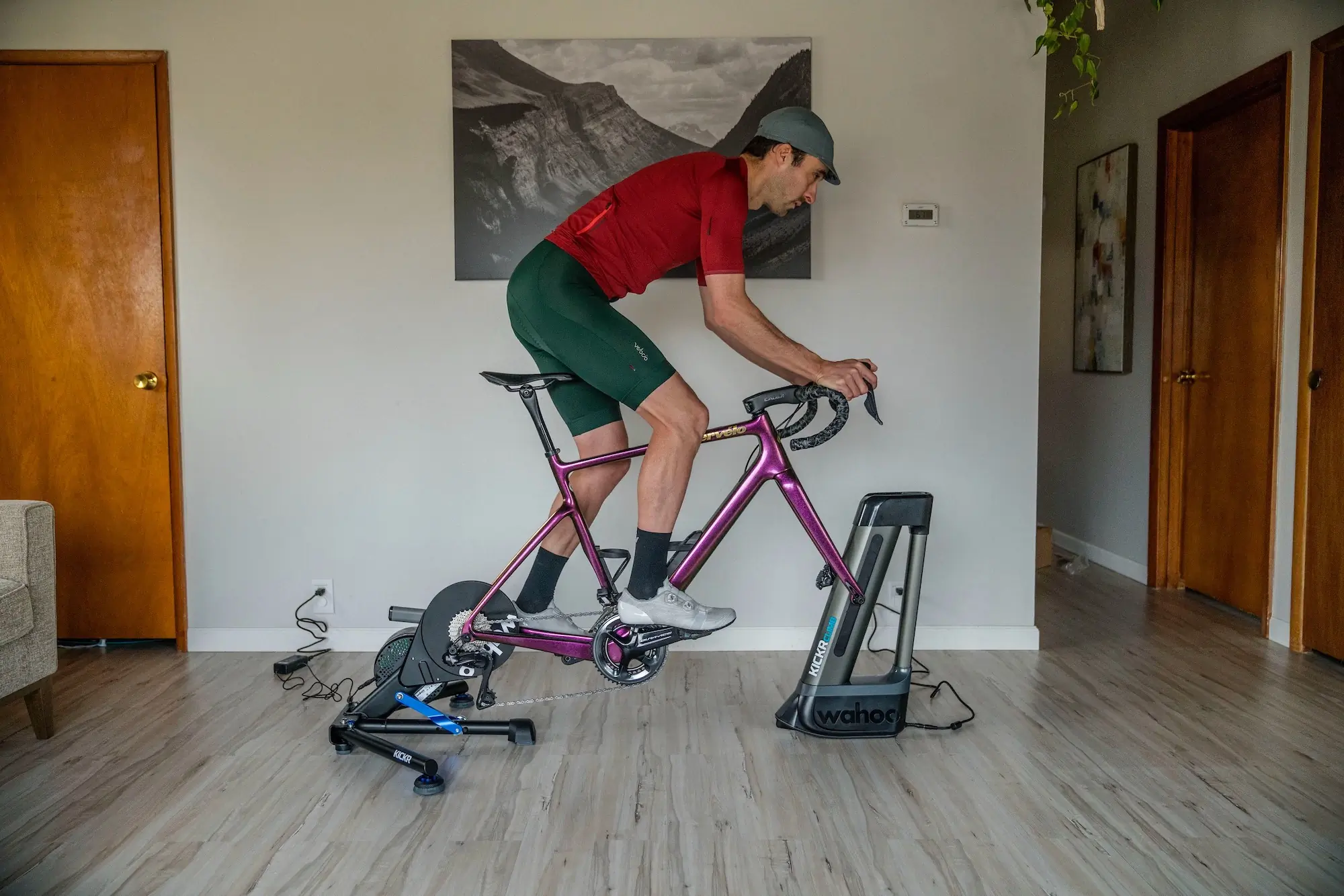
Our Expert Testers
Our bike trainer test team consists of Bennett Shane and Jeremy Benson, both of whom have been using bike trainers for over 20 years. Bennett is a dedicated road cyclist who spent years rubbing elbows in races but has transitioned into fatherhood while riding for fun, fitness, and, of course, product testing. Bennett spent years working for numerous prominent brands in the cycling industry and has an uncanny depth of knowledge about all things cycling-related.
Hailing from the Pacific Northwest, Bennett is no stranger to inclement weather and has spent an inordinate amount of time riding indoors in the darker months or when the rain is falling — which it often does. As such, he has grown an appreciation for quality indoor workouts and has tried nearly every bike trainer on the market over the years. Since he doesn’t always ride inside, Bennett has contributed to winter apparel guides, including the best cycling jackets and our favorite winter cycling gloves.
GearJunkie editor Jeremy Benson started riding indoor trainers in the late ’90s. While his cheap mag trainer and Tour de France recordings got the job done, he’s slowly but surely found himself being dragged into the Zwift world, which he finds to be an engaging and challenging way to boost fitness when he might otherwise be languishing on the couch.
As an aging competitive gravel and mountain bike racer, maintaining his fitness is incredibly important, particularly during the fall, winter, and spring, when snow often prohibits outdoor riding in the mountains where he lives. He’s no stranger to the pain cave, and he has an impressive collection of small fans which he uses to try and prevent large puddles of sweat from forming in his garage while he attempts to increase his FTP, which is still fairly low. In the warmer months, Jeremy tests a wide range of cycling gear, including the best mountain bike helmets, mountain bike shoes, and hitch bike racks.
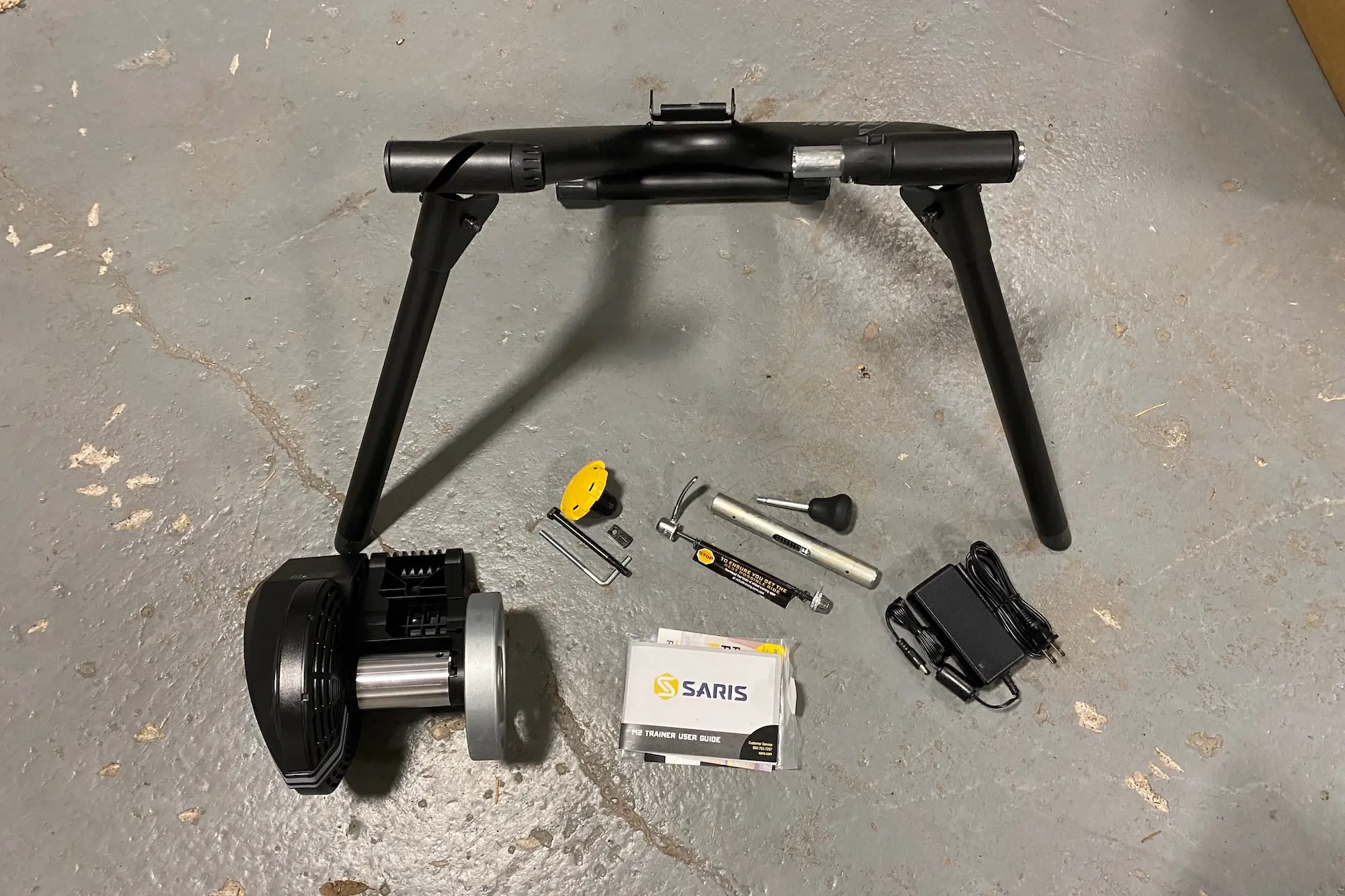



Our Testing Process
After researching the best bike trainers on the market, we chose a selection of 9 models for real-world testing and comparison. Each model was shipped directly to either Bennett or Jeremy, who unboxed them and set them up just as any consumer would. This gave us the chance to examine compatibility with different bikes, axles, and drivetrains.
After setting them up, we connected to each model’s respective companion app and then to our favorite training apps to assess connectivity and compatibility. Then, we settled into weeks and months of indoor workouts ranging in intensity from casual “rest days” to all-out efforts while gunning for new PRs in Watopia.
While testing, we focused on important performance characteristics like trainer stability, ride feel, resistance quality, connectivity, and noise levels. We switched between trainers frequently for back-to-back comparison and to tease out the often subtle differences that separate the best from the rest.
After months of testing and thousands of virtual miles, we compared notes and chose our favorite bike trainers and those that stand out in specific ways compared to the rest.
Buyer’s Guide: How to Choose a Bike Trainer
With so many bike trainers on the market, choosing the right one can be a challenge. Below, we’ll break down the important factors to consider when deciding which bike trainer suits your needs and training goals. Don’t forget to check out our guides to the best cycling bib shorts, top-rated road bike shoes, and high-performance road bike saddles if you need any other gear to round out your indoor cycling setup.
Types of Bike Trainers
Bike trainers are designed for more serious and realistic indoor cycling for those seeking to simulate an actual ride or training session. Bike Trainers are generally split up into three main categories: rollers, wheel-on trainers, and direct-drive trainers.
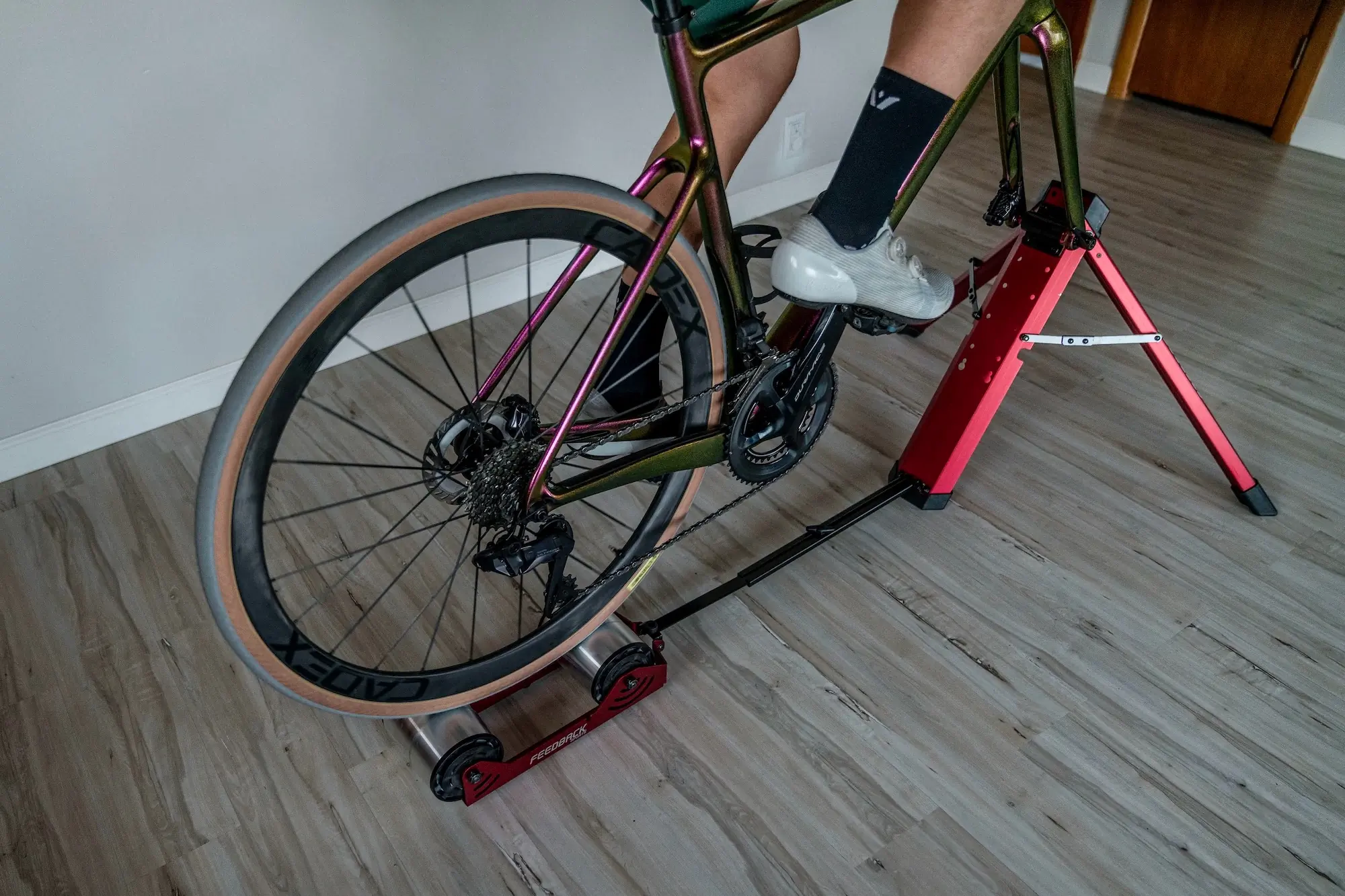



Rollers
Roller trainers are the OGs of the trainer world. These are the simplest forms of bike trainers, consisting of a set of three rollers within a frame. You place your tires on the rollers and ride it the same as you would if you were outside.
As you ride, the two back rollers that contact your rear wheel spin. The rear rollers are connected to the front roller that sits under your front tire so that it spins along with your back tire. This not only gives you a solid workout but also forces you to work on your balance and bike control while you train.
It takes some practice to get used to — we recommend setting it up next to a wall so you can brace your hand against it while you get used to the balance. Rollers are the simplest and among the least expensive and most portable options.
That said, the simplicity of traditional rollers means that most don’t have any connectivity or allow for any resistance changes — your workout is up to you. There is a new breed of powered rollers, however, which can provide resistance and work with training apps. Additionally, there are some hybrid-style rollers on the market, like the Feedback Sports Omnium Over-Drive, which uses rollers on the back wheel while supporting the fork.
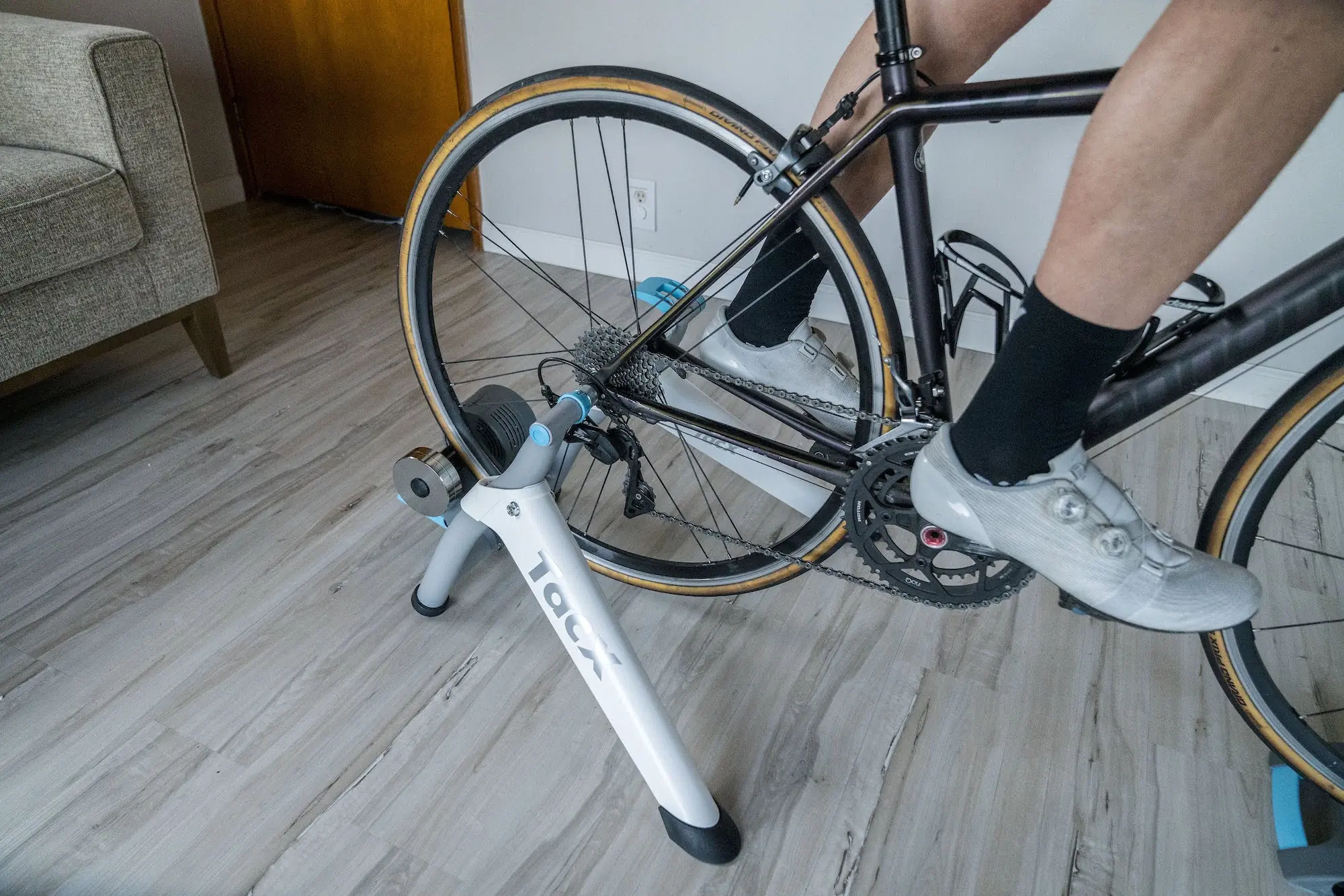



Wheel-On Trainers
Wheel-on trainers, sometimes called “tire-drive,” attach to the rear axle of your bike. The rear tire contacts and rolls on a smooth drum on the resistance unit. The trainer’s footing provides stability, so you don’t need to focus on balance the way you do with rollers. Wheel-on trainers typically fold down to be quite small, and they weigh less than direct-drive models.
They also make it quicker and easier to install and remove your bike since you don’t need to remove the rear wheel or fiddle around with swapping your cassette over. For this reason, they are a convenient option, especially for those short on space who may not leave their bike trainer set up at all times.
Wheel-on trainers also provide varying amounts of resistance, so you can adjust your difficulty to suit your needs. The least expensive wheel-on trainers, like the Alpcour Bike Trainer, typically don’t have any “smart” features or connectivity. Instead, the resistance can be controlled manually to vary the intensity of your workout.
Many modern wheel-on trainers do have “smart” features, however, so they can sync via ANT+ or Bluetooth to your device for use with popular training apps. The Garmin TacX Flow, Saris M2 Smart, and the Wahoo Fitness KICKR SNAP are all examples of smart wheel-on trainers.
These models use integrated sensors to track power, cadence, and speed and transmit that to your device. Meanwhile, the trainer automatically changes resistance based on the virtual terrain of the course you’re riding.
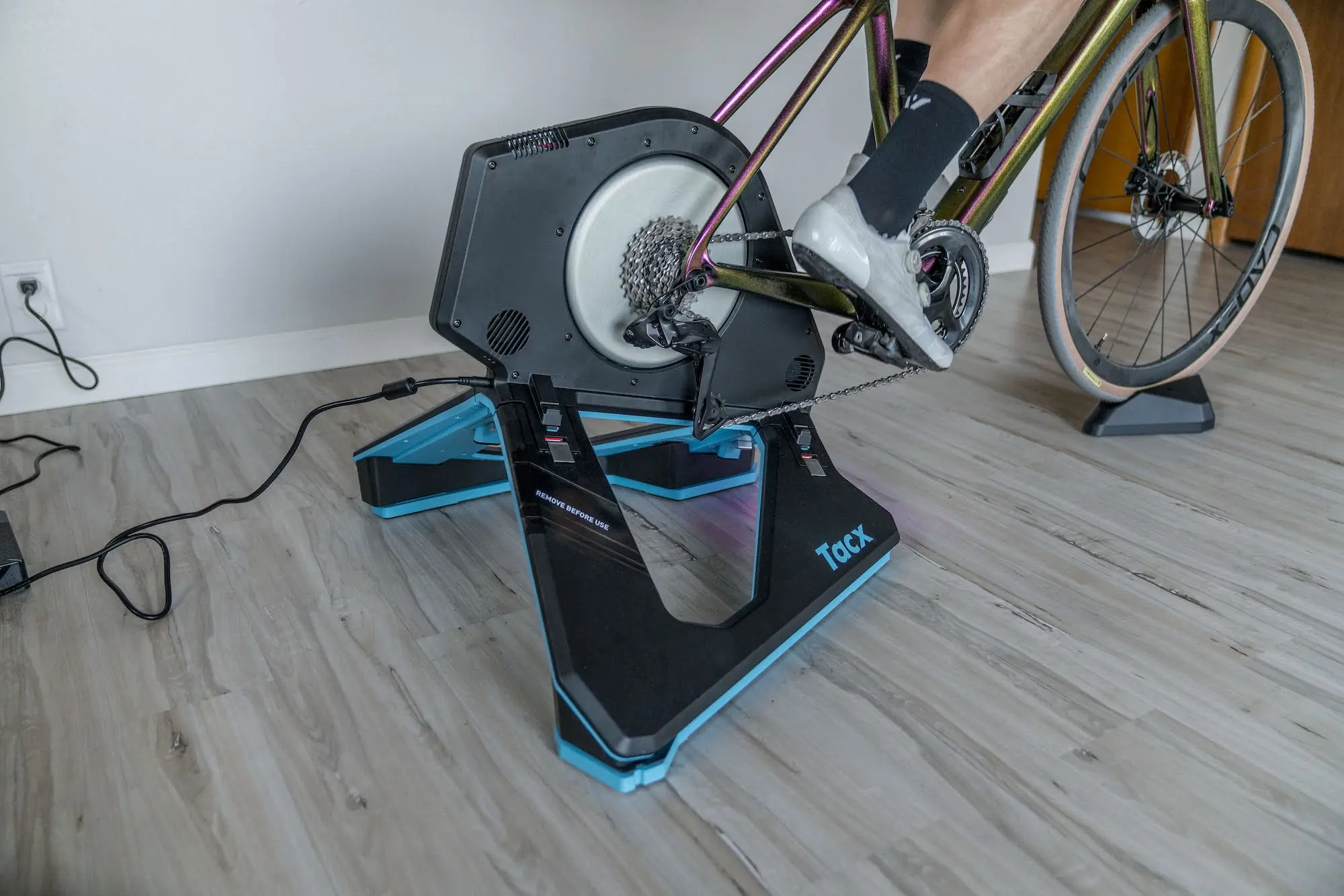



Direct-Drive Trainers
Direct-drive trainers are the latest and arguably the best type of trainer for serious indoor cycling. They get their name from the fact that the rear wheel is removed, and you connect your trainer directly to your bike’s rear axle and drivetrain. This direct connection to the bike is typically impressively stable, and it also eliminates variables like tire pressure which can throw off resistance or power data with wheel-on models.
Speaking of data, direct-drive trainers are almost always “smart,” and they will connect to popular training apps via ANT+ or Bluetooth for virtual training sessions on Zwift, Rouvy, TrainerRoad, and more. Additionally, direct-drive trainers can provide the most realistic ride feel with “erg modes” that change resistance to simulate climbing hills, maintaining momentum, and coasting based on the terrain on virtual courses. In some cases, they even mimic different types of roads like gravel and cobblestone roads.
Additionally, direct-drive trainers can typically handle the most power, with some capable of handling 2,000+ W. On top of that, they also tend to be the most accurate, with some, like the Wahoo KICKR and the Garmin TacX Neo 2T boasting accuracy of ±1%. While this type of power and accuracy won’t matter to everyone, it can be very important to those who are competing on Zwift or trying to hit very specific performance targets.
Direct-drive trainers also happen to be among the most expensive options, although their price has come down slightly in recent years and they can often be found at deep discounts, particularly when a new or updated model comes out.


Connectivity & Training Apps
Many trainers — direct-drive trainers and many wheel-on models — feature Bluetooth and ANT+ capability to work out with apps like Zwift, Sufferfest, and Strava. These apps will do everything from tracking your ride stats like power output, distance, and cadence, to allowing you to participate in virtual group rides and races while making automatic changes to resistance based on the course you’re riding.
They can even let you ride real routes around the world from your garage, mimicking the distance, inclines, resistance, and, in some cases, even the texture of the road. Most apps also will put your virtual ride on a screen — laptop, tablet, or connected television — letting you see the course or views that you’d be seeing if you were out on your ride. For many indoor cyclists, this type of virtual riding is far more motivating, interesting, and engaging than staring at a wall or watching Netflix while you spin away the time.
Many bike trainers come with a free trial for Zwift or a similar app, after which you’ll need to pay for a monthly or annual membership or subscription to use the service. Zwift is the most popular, but there are several others, like Rouvy, the Sufferfest, KinoMap, and Wahoo SYSTM, to choose from.
We recommend trying a few different apps out before deciding which suits you and your training goals the best. You’ll also want to factor in the price of an app membership, as that will add to the cost of your training routine. For example, a Zwift membership currently costs $200 per year or $20 per month.




Realistic Road Feel
Road feel tends to increase as you go up the price ladder. Rollers are the most basic, providing little resistance as you ride. A few models will add some resistance as you sprint, but the power will be limited. The realism of rollers comes from you having to balance and control your bike to keep it on the rollers while you ride.
Wheel-on trainers offer more resistance to provide a more realistic sensation of riding, letting you mimic sprints and inclines. While the balance that you get from rollers isn’t there, the added power for resistance is a huge plus for cyclists looking to increase their fitness.
Direct-drive trainers go the distance when it comes to simulating the feel of riding on a road. Smart trainers will connect with apps to put you on predetermined routes and automatically adjust the resistance to simulate hill climbs and sprints. Many also feature “erg modes,” which allow the trainer to adjust resistance to maintain a predetermined power target while doing interval workouts. Direct drive trainers also simulate inertia and the feel of momentum and coasting on descents.
Some companies, like Tacx, go the extra mile by adding Road Feel, which automatically recreates the feel of riding on different roads during your ride. Depending on where your training app takes you, Tacx’s trainers can simulate vibration over surfaces like cobblestones and gravel.
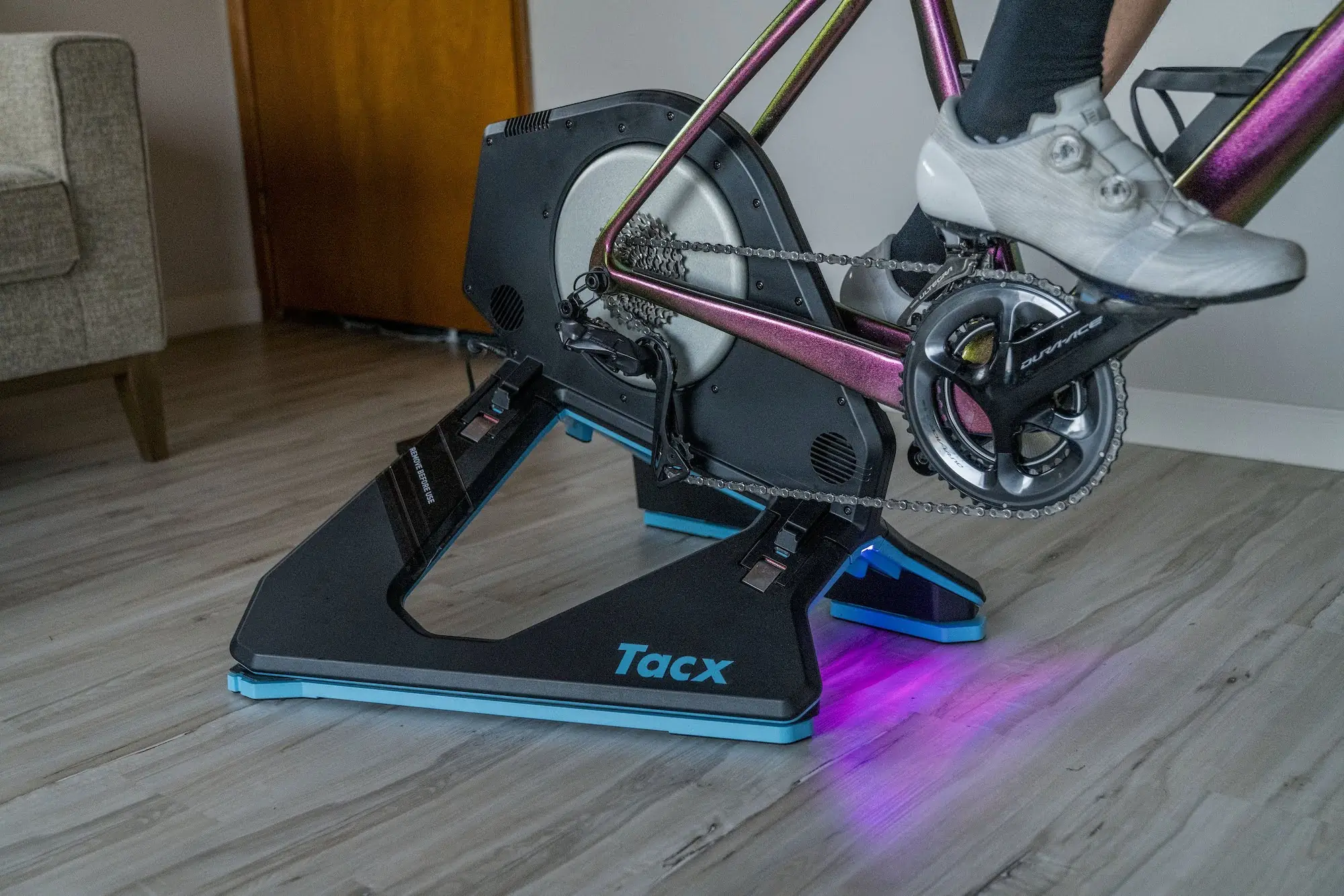



Accessories
Since even the most advanced wheel-on and direct-drive bike trainers can only do so much to simulate the feel of riding in the real world, there is a wealth of accessories on the market to enhance your indoor riding experience. One thing’s for sure, if you’re planning to spend lots of time in your own personal pain cave, it pays to deck it out for comfort. If you’re using training apps, having a platform or table to hold your device for easy viewing is pretty nice.
Additionally, we think a fan is an absolute necessity to keep some air moving around you and reduce the incredible amount of sweat that will inevitably be pouring from your body. Virtually any fan will do, but there are trainer-specific fans on the market for those interested.
The Wahoo KICKR Headwind ($300) is a good example. This fan has a “targeted airflow pattern” and can produce wind speeds up to 30 mph. It can also be paired to your devices so you can adjust the fan speed from your device or with your heart rate monitor so it adjusts according to your heart rate.
Since riding indoors often involves significant amounts of sweat, a trainer mat is a worthwhile purchase. Not only will it help stabilize your trainer, but it will also catch your sweat and any grease from your chain to protect your carpet, wood floor, or garage concrete. Cleaning a trainer mat is far easier than cleaning your carpet.
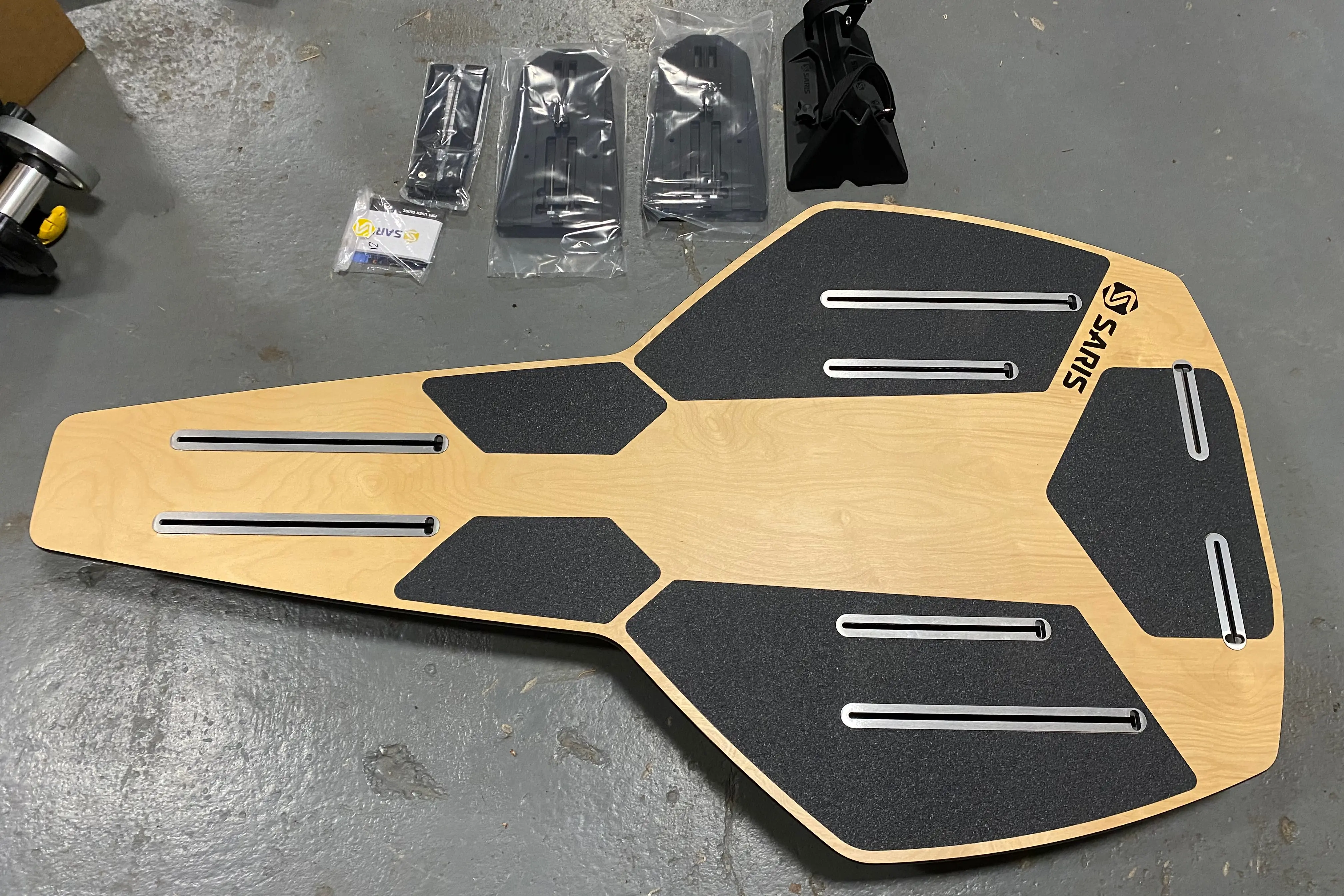



One of the big complaints about bike trainers is that they feel so static. Unlike riding outside, the bike is fixed in position while connected to the trainer, which feels pretty unnatural, comparatively speaking. Wahoo has tried to combat this with its Axis Feet on the KICKR, but that only does so much.
Garmin’s answer is the TacX Neo Motion Plates ($300), which connect to the feet of the Neo 2T trainer to provide up to 50 mm of fore/aft motion. Taking it a step further, the Saris MP1 Nfinity platform ($950) is a more comprehensive solution and the best we’ve tried.
By supporting the trainer, bike, and rider, the MP1 platform can rock from side to side and move fore/aft with the rider. While it still doesn’t feel completely natural, it’s much closer than anything else on the market. It also works with virtually any trainer.
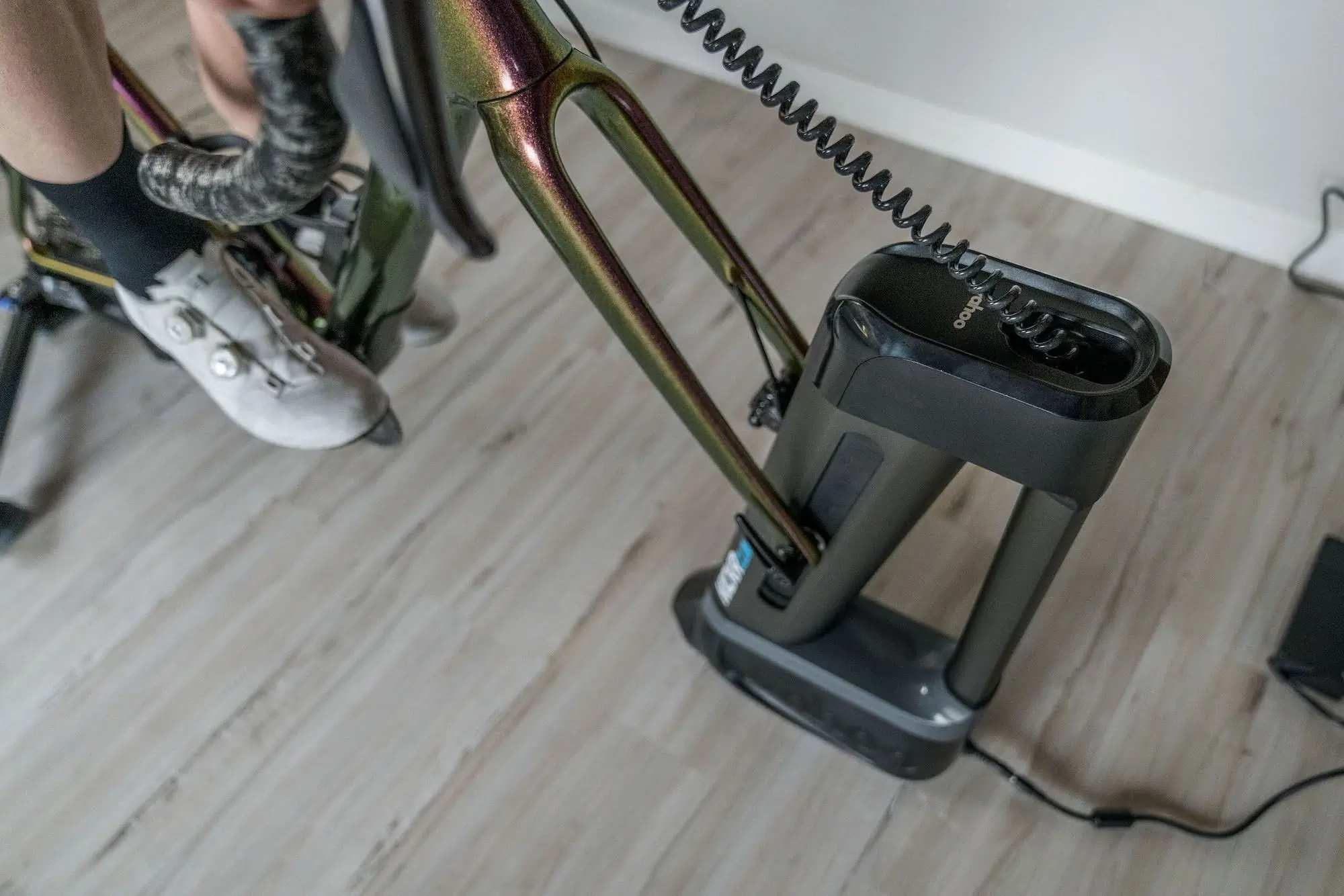



Another interesting option is the Wahoo KICKR Climb ($700). This accessory simulates inclines that correspond with the elevation profiles of routes on Zwift and other popular training apps. It is only compatible with Wahoo KICKR trainers, but it can simulate inclines up to 20% and declines as steep as 10%. Another similar product is the Elite Rizer ($1,000) which functions similarly.
While these are very niche products, they can make the experience of riding indoors more fun and mentally engaging. If that translates to more training getting done, then it could help you be more fit and thus better at riding uphill.
Bike Compatibility
The best trainer in the world is useless if your bike won’t fit. It’s important to do a little research to make sure that your bike will fit before dropping in on a purchase. Often, this may require purchasing an adapter or cassette.
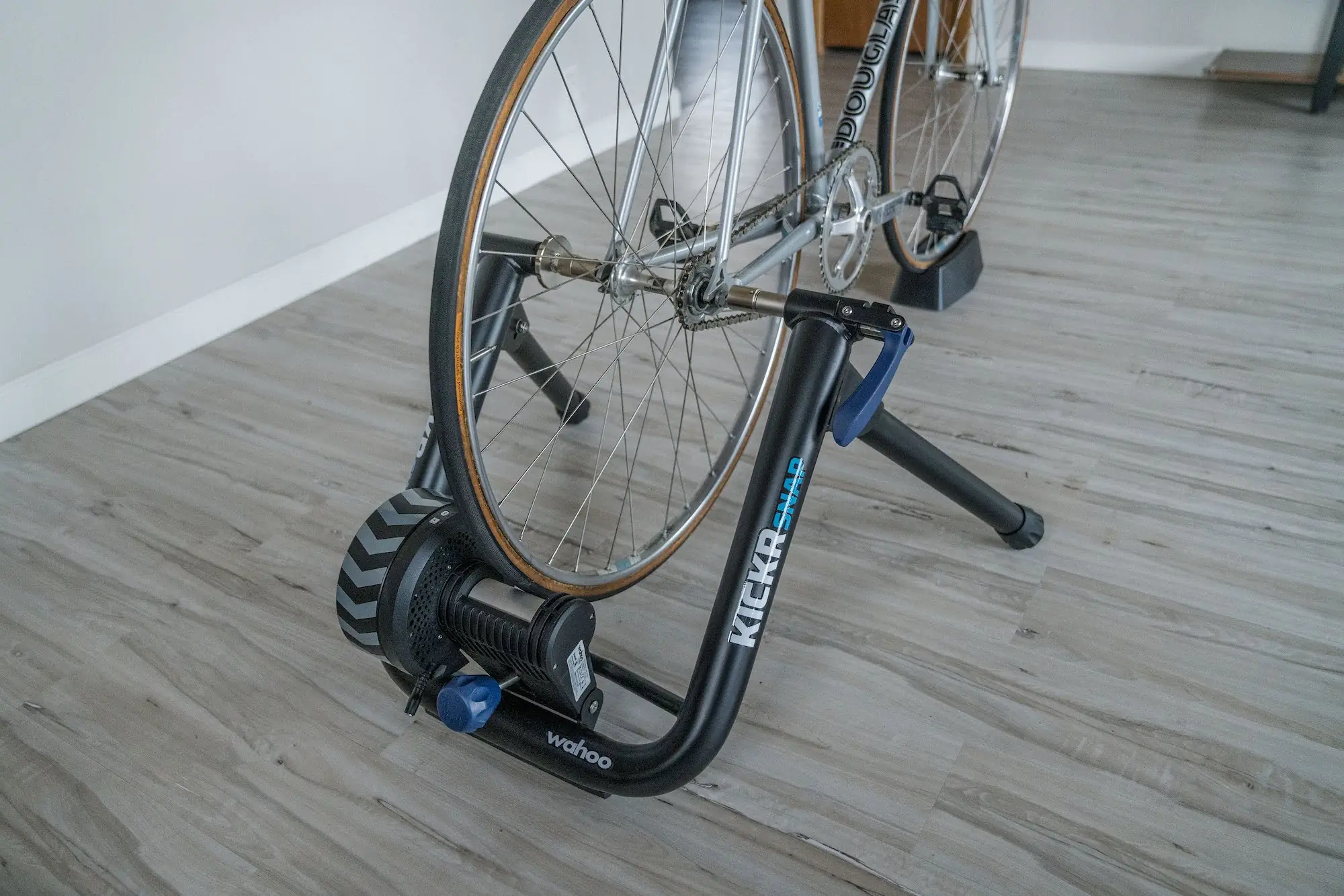



Roller trainers are the most versatile, as they only have to consider the distance between the front and back tires. Rollers will work with virtually any bike, but you’ll want to be sure to use slick, road-style tires for smooth rolling on the rollers.
Wheel-on trainers will work with most bikes with wheel sizes between 26-inch and 29-inch/700c, given the fact that the resistance unit is adjustable to achieve proper pressure against the tire. That said, you will want to use a slick, road-style tire on the rear wheel, as it will interface and roll the most smoothly over the resistance drum where it makes contact.
The other consideration is axle spacing and axle type. Most wheel-on trainers come set up to work with traditional quick-release skewers, although most also offer adapters to work with thru-axles and wider spacing common on most modern bikes.
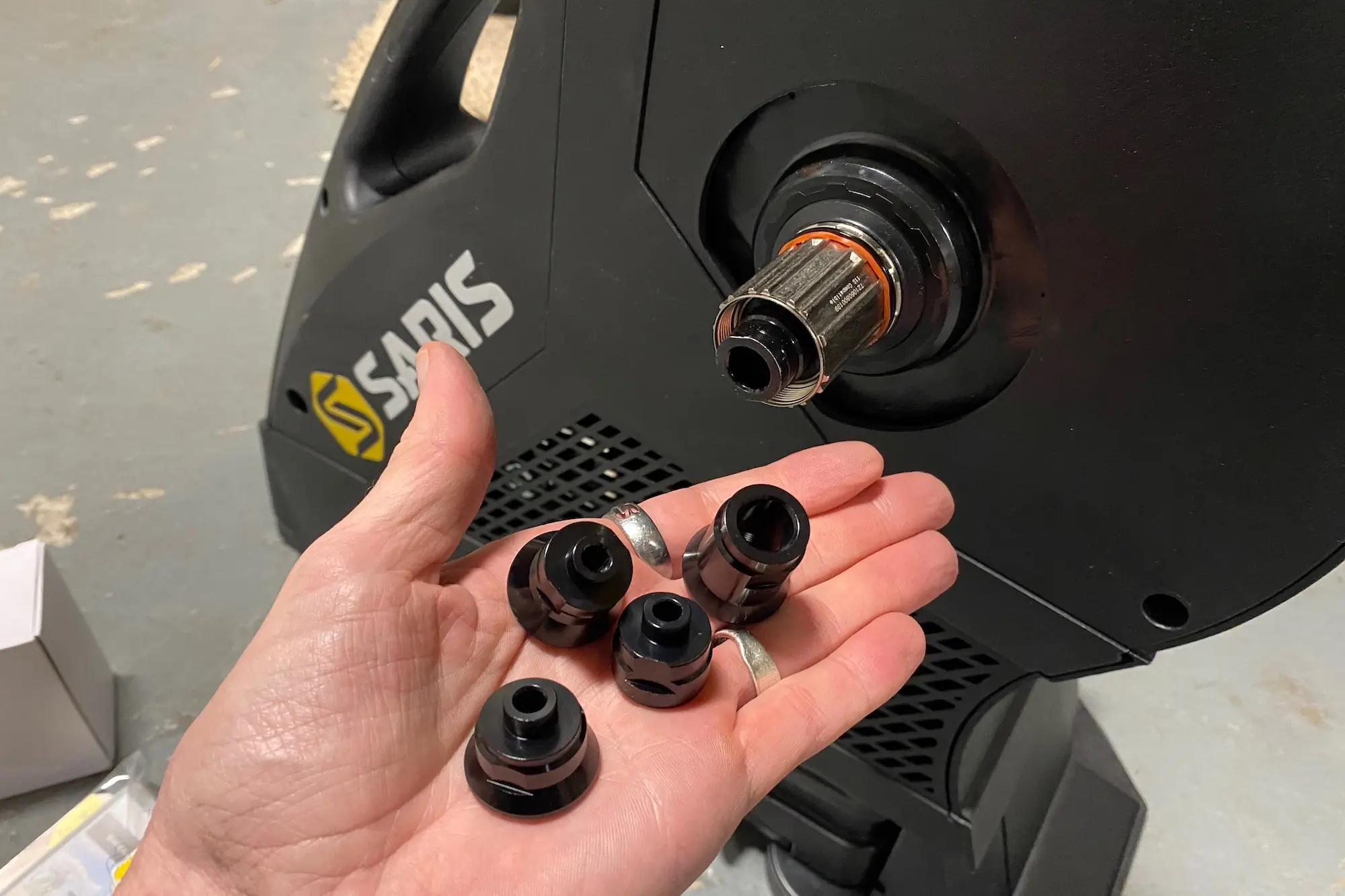



Likewise, direct-drive trainers vary somewhat in their compatibility out of the box, but most will work with most bikes — though you may need to purchase adapters or a cassette for a perfect match. For example, the Saris H3 Plus comes with a Shimano HG-freehub body that will work with most Shimano and SRAM road cassettes between 8 and 12 speeds.
It does not come with a cassette, however, so you’ll either need to purchase one for use on the trainer or swap the one from your rear wheel. If you use a cassette that requires a SRAM XD or XD-R freehub, you’ll need to purchase that separately.
Fortunately, the H3 Plus comes with a variety of swappable end caps to fit the majority of axle types and widths, including 130 and 135 mm quick-release and 142 and 148mm thru-axles. So, that covers pretty much everything.
If you’re purchasing a direct-drive trainer and use a cassette that requires a freehub body for Campagnolo, SRAM XD/XD-R, or Shimano Microspline, you’ll definitely want to double check to make sure that is available.
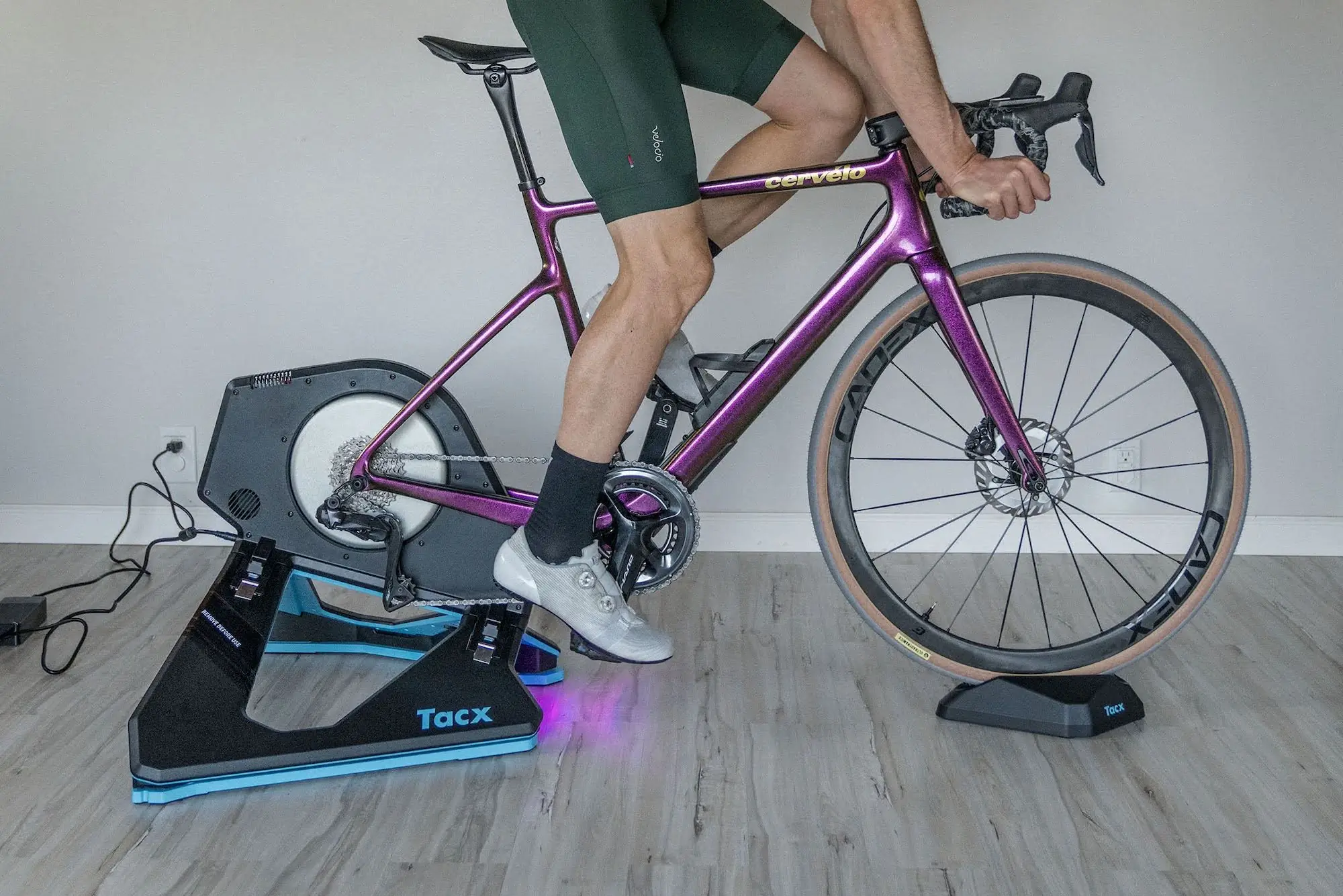



Noise
One of the biggest issues that people have with bike trainers is the noise they generate, especially if you live with someone or work out in a space that shares walls with neighbors. While bike trainers used to be pretty noisy, most modern models have managed to reduce the decibels to tolerable levels.
Fluid and magnetic wheel-on trainers can cause a ruckus, but most now incorporate sound dampers to keep the noise down. Some of the better ones will put out decibels in the mid-50s at 20 mph, which is roughly the sound of indoor conversation.
If you don’t want to spend the money on a direct-drive trainer, you can get a trainer tire to use when you ride indoors. Trainer tires are designed specifically for use with a roller, built with softer compounds than standard road tires, so they grip the roller better. The smooth tread also minimizes the noise coming from the tire when you train. Trainer tires work for outdoor road riding, but the road wear will eventually cut the tire’s lifespan short.
If you tend to alternate between indoor and outdoor riding, having a separate wheel with a trainer tire on it will make it a lot easier to switch between indoor and outdoor training.
Rollers are generally quieter than wheel-on, but the tires moving on the rollers can still be loud.
Direct-drive trainers tend to be the least noisy. They’re more built-up, with bigger, enclosed units that usually sport sound-damping methods to ensure that the machine itself emits minimal noise. More importantly, there’s no sound from the wheels moving against rollers, as the bike’s drivetrain is attached directly to the trainer itself. Often, direct-drive trainers put out less noise than you would riding outdoors, as it’s just the sound of your drivetrain, and none coming from the wheels or tires.
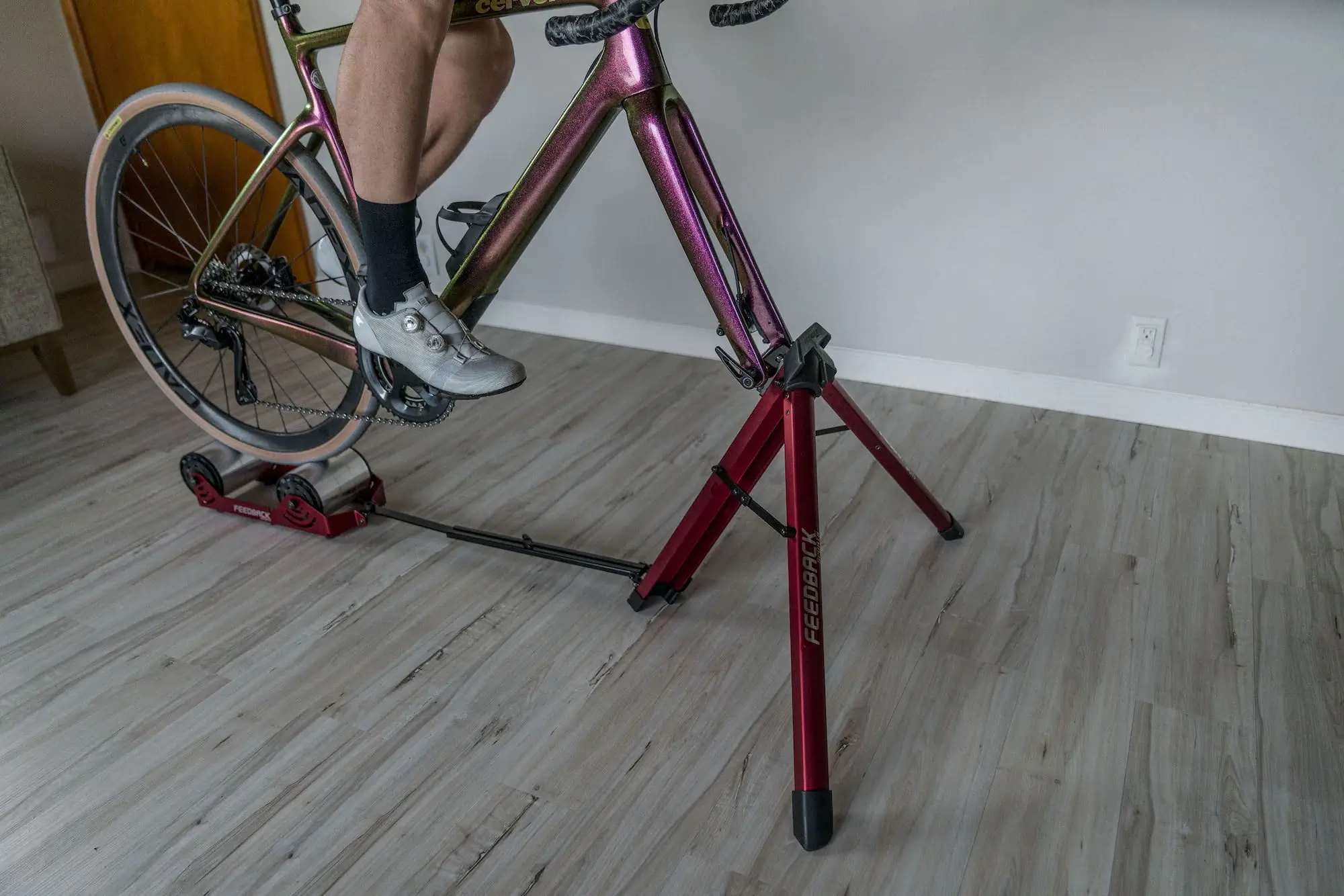



Storage and Portability
If you don’t have a dedicated space for your trainer, storage and portability are important considerations. Most trainers are easy enough to move around occasionally and don’t take up too much space on their own, but some are far more portable and storable than others.
Rollers are generally the easiest to transport. Consisting of a frame with three aluminum rollers in it, they tend to weigh around 20 pounds and are easy to carry around when they are folded down. This makes them especially handy if you want to take them with you for a quick on-site warmup on race day.
Additionally, you don’t attach the bike to traditional rollers like the Saris Aluminum Rollers, so there isn’t any setup required to use them other than putting them on the floor. The Feedback Sports Omnium Over-Drive takes the cake here, as this roller hybrid weighs only 14 pounds and folds down smaller than any other model we’ve tried.
Wheel-on trainers typically have support legs that fold in and are usually much lighter than their direct-drive counterparts. Additionally, it’s quicker and easier to attach and remove the bike, so putting them away between uses is more user-friendly. Not only are they easy to carry, but they don’t take up much storage space either.
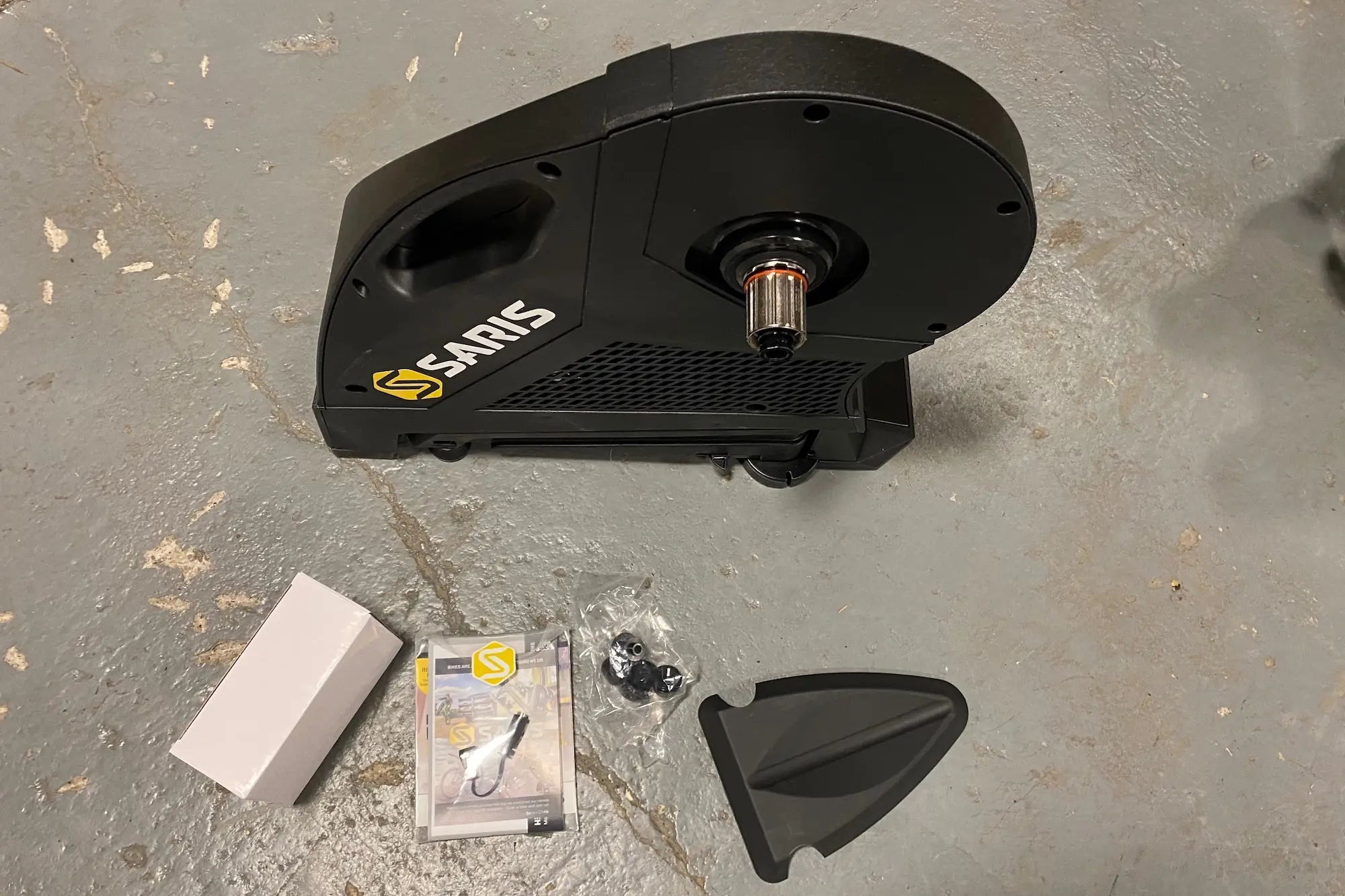



Direct-drive trainers tend to be the heaviest, with the weights of the models we tested all around 47 to 48 pounds. Most have handles to facilitate moving them around, but they are still about twice the weight of most wheel-on models. Fortunately, the legs of direct-drive trainers usually fold in to minimize their footprint and overall size when not in use, so they don’t take up too much space in your closet or garage.
That said, it is usually a bit more time-intensive to get your bike set up on a direct-drive trainer as you have to remove the rear wheel — and possibly swap the cassette over — each time. We find it’s best to leave these set up for extended periods when possible.
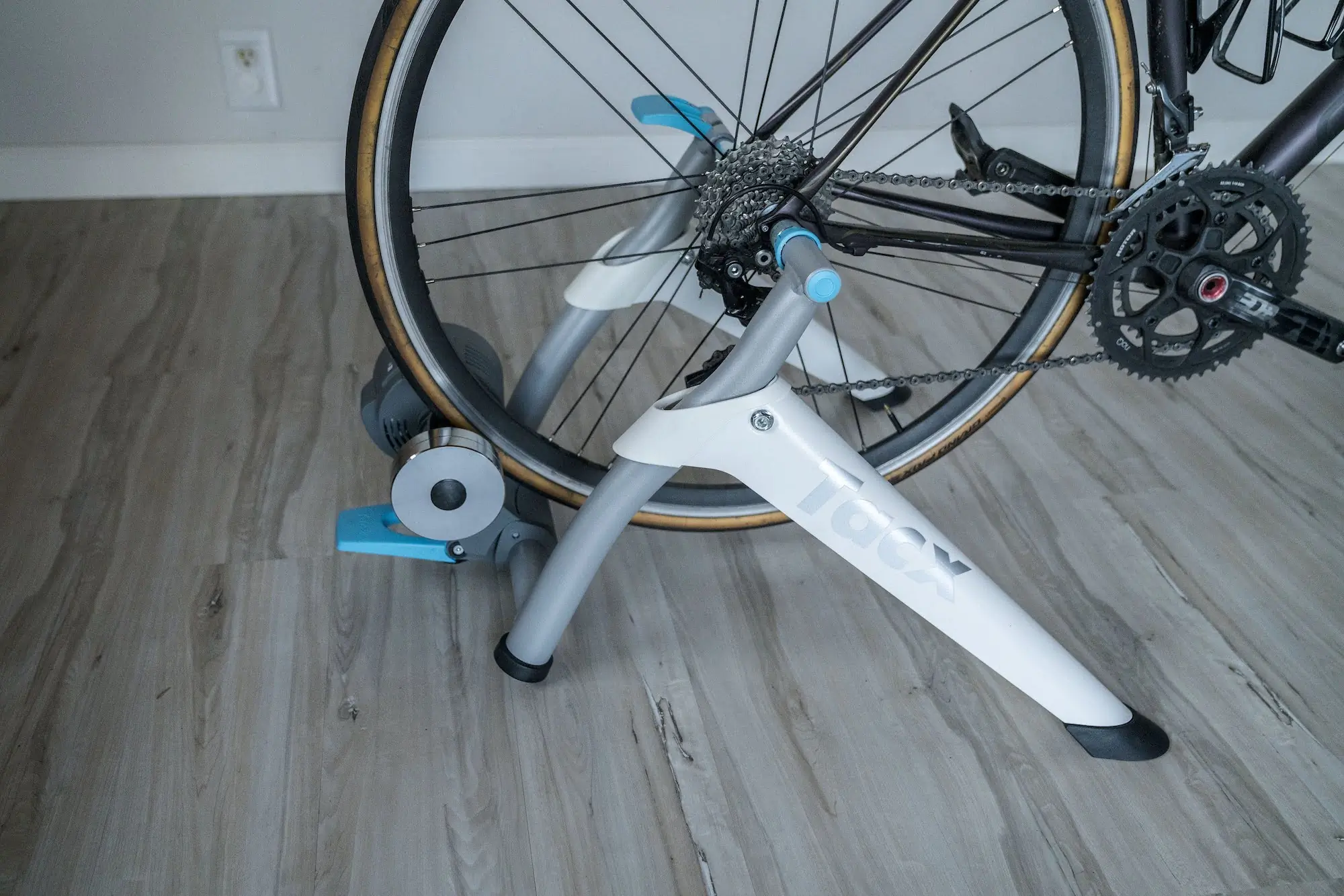



Ease of Setup
When it comes to setup, the more complicated your trainer, the more setting up is involved. Rollers are by far the easiest since it’s basically a treadmill for your bike. Just put your bike on the rollers, hop on the bike, and get pedaling.
Wheel-on rollers take a tiny bit more effort, but you can still set your bike up in a few minutes. Simply adjust the clamps to fit your bike’s rear axle and lock it in. Then adjust the roller so that it meets the rear wheel with the appropriate amount of tension/pressure. After that, you’re ready to (not) roll. the caveat here is that you may need to acquire an adapter to fit your specific axle type/size, but once you have that, setup is quick and easy.
Direct-drive systems take a little more time and effort. You have to remove the rear wheel and attach the bike to the trainer’s cassette, which requires some familiarity with bike mechanics. As mentioned previously, you may need to switch around axle adapters to work with your axle size/type, and you may need to purchase a cassette or freehub body (or both) for compatibility with your drivetrain setup. Also, smart trainers require an initial setup to connect with apps and devices on their first use — and occasional firmware updates and/or calibration from time to time.
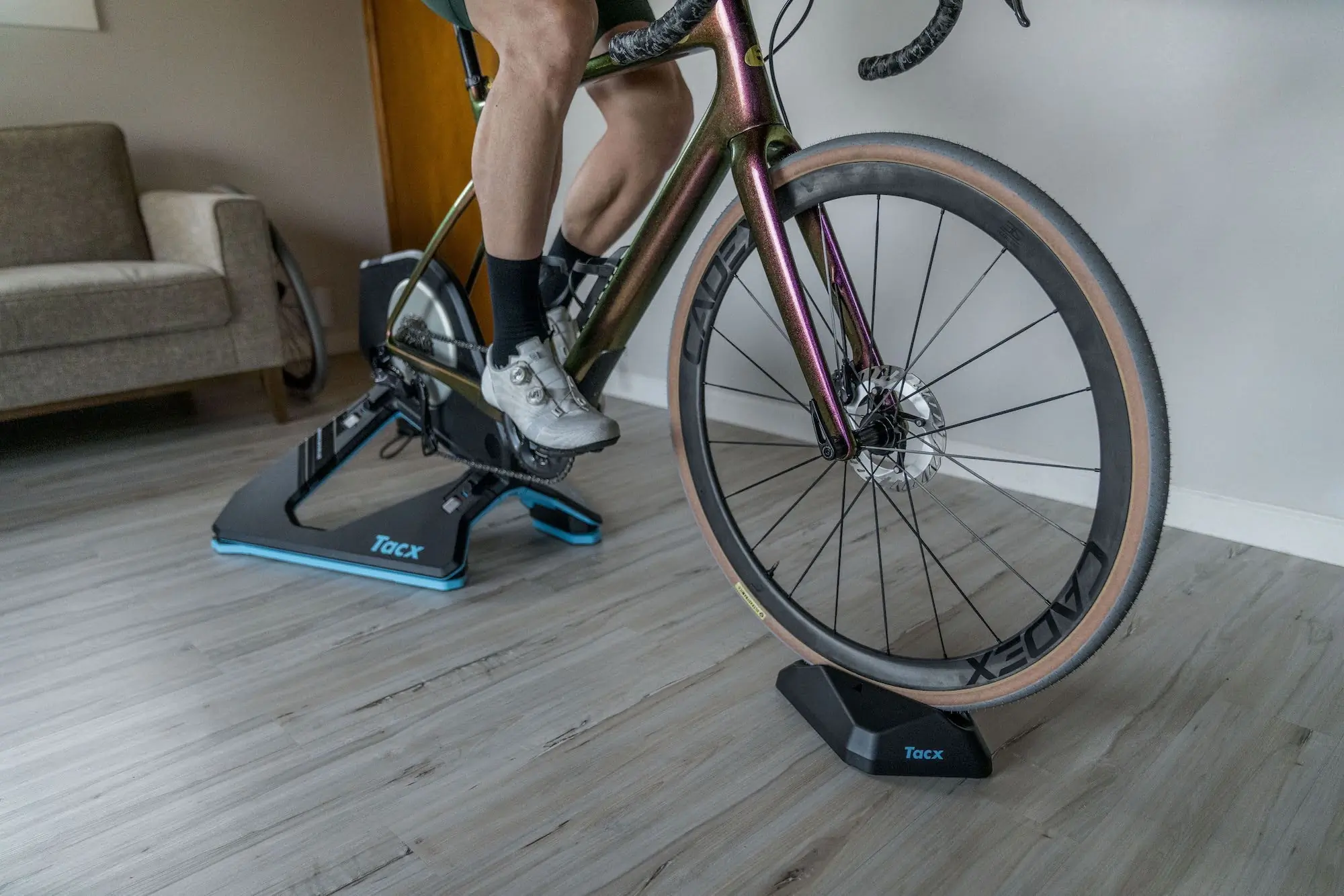



Durability
Traditionally, the fewer moving parts that a machine has, the fewer things can go wrong. The same holds true with trainers.
Thanks to their simple design and construction, most can last for years without any issues. Just make sure you don’t accidentally drive over it when pulling into your garage.
With wheel-on trainers, heat buildup can be an issue. Fortunately, most models have cooling features that minimize failure due to heat buildup over time. The sturdy aluminum frames are practically bombproof. Some companies are so confident in their frames that they’ll offer unconditional lifetime warranties.
Direct-drive trainers are the most complex, which means more things can go wrong. The build quality is generally the same as with wheel-on trainers. The issues that pop up with these tend to be in a machine’s smart features. A smart sensor going out or Bluetooth not connecting are common complaints.
Most trainers are built to last, so it’s hard to go wrong when choosing a type. Try to buy one from a reputable, well-known company. Many trainers have a good warranty and/or replacement policy, so look online to see what’s covered. Also, be sure to check out any online bike trainer reviews for durability issues.
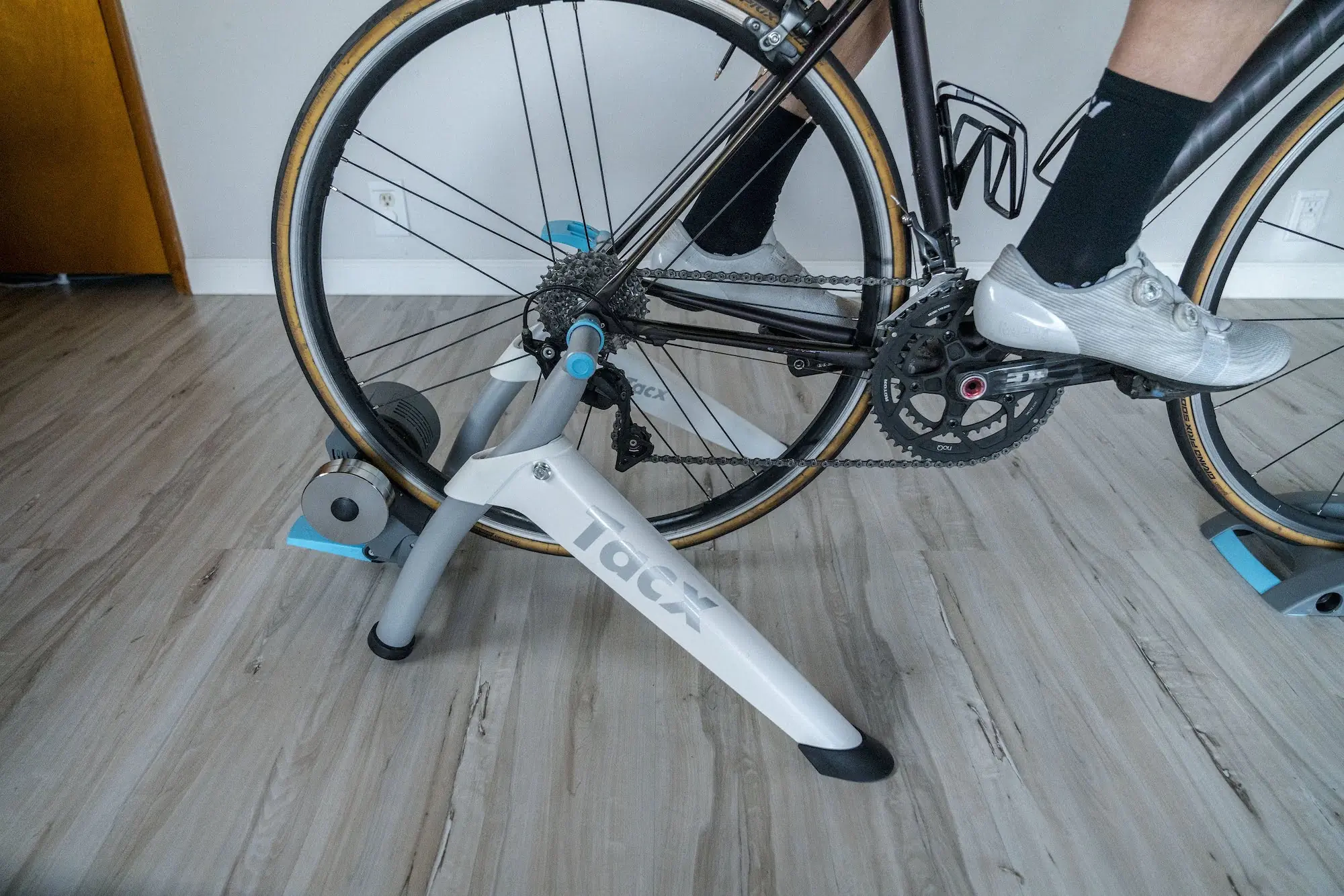



Price & Value
Like anything else in the sport of cycling, bike trainers come at a wide range of prices with models ranging from around $150 all the way up to $2,000 for the latest and greatest. The difference in prices reflects the level of complexity and technology, with more basic, but still functional, models costing less than the more advanced high-end training tools.
Budget
If you’re simply looking for something to spin the legs, boost the heart rate, and burn some calories, then a budget-friendly bike trainer like the Alpcour Bike Trainer ($160) will do the trick. This simple wheel-on model is easy to set up and use, with six levels of manually adjustable resistance to get the muscles burning and your heart pounding.
It foregoes smart features in favor of simplicity, and it gets the job done for a fraction of the price of “smart” trainers. If you’re an infrequent indoor rider or you don’t care about tracking data or virtual riding apps, this is an affordable option that will give you years of faithful service.
Mid-Tier
Climbing up above the $300 mark, we start to see trainers with smart features and connectivity for use with training apps. Generally, we also see higher-quality materials, more refined finishes, and a reduction in noise. The Wahoo Fitness KICKR SNAP ($350) is a high-quality wheel-on trainer with connected features. Not only will it pair with your devices and apps for data tracking and virtual training, but it can handle up to 1,500 W of power, boasts ±3% accuracy, and can simulate grades up to 12% — impressive stats for a wheel-on model.
The Saris H3 Plus used to retail for $700, but the price has recently been reduced to $400. While that means Saris is likely coming out with a new or updated version, it means that riders can get this fantastic training tool for less than just about any other direct-drive trainer on the market. Best of all, it performs nearly the same as the premium models, with the ability to provide up to 2,000 W of resistance, ±2% accuracy, and seamless compatibility with all the popular training apps.
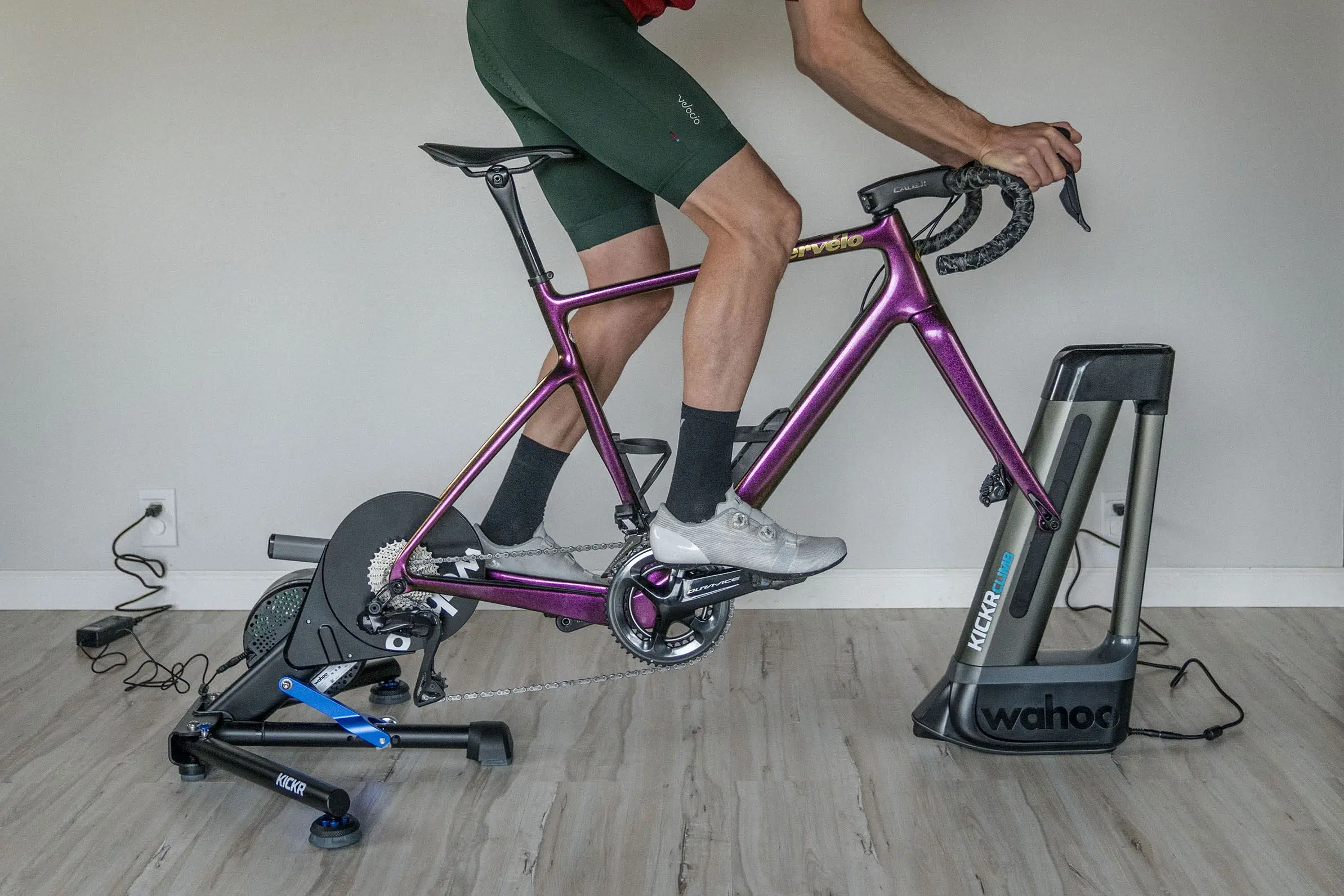



Premium
The high-end bike trainer market includes models that cost $750 and up. Top-of-the-line direct-drive bike trainers used to top out at around $1,400, but nowadays, you can spend as much as $2,000 on the latest TacX Neo 3M. Fortunately, the prices of many top-tier trainers have come down recently, with the most expensive models we tested costing between $900 and $1,000. What does spending more get you? In general, when you spend more, you get higher maximum power ratings and improved accuracy.
For example, the TacX Neo 2T ($900) boasts resistance up to 2,200 W, power accuracy of ±1%, the ability to simulate grades up to 25%, a sleek form factor, and a super sturdy construction. Likewise, the Wahoo KICKR ($1,000) almost matches those performance specs but comes with Axis Feet and a pre-installed 11-speed cassette.
Should everyone spend that much? For those who are super serious about their training, especially those competing in virtual races on Zwift, spending more is almost certainly worth it. Consider your goals and how much you plan to use it, and you should be able to narrow down the choices to find the right bike trainer for your needs.
Frequently Asked Questions
The question of rollers versus wheel-on or direct-drive trainers depends on how you specifically want to train. How much you are willing to spend is also a factor.
Roller trainers are great for their simplicity and mobility. They’re great for riders who ride indoors and outdoors in equal measures because there’s no installation required. They tend to last a long time, they’re inexpensive, and they are easy to store and transport. This makes them a good option for travel and pre-race warm-ups.
The simplicity comes at a cost, however. Most traditional rollers do not have the power or “smart” capabilities of their more complicated counterparts — although some do these days.
On the other end of the spectrum are direct-drive trainers. They are on the top end of the price spectrum, and they’re often double the weight of roller trainers. They also take a bit of mechanical know-how to attach and remove your bike. On the other hand, they offer just about everything you’d need to optimize your training.
The power output for resistance is spectacular, and they can simulate inclines (we’ve seen some that go to 25%). Smart ones work with apps to allow you to participate in virtual races. You can also access training, track your workout statistics, and even replicate roads down to the texture. This is a huge bonus for cyclists who want to mimic riding outside.
Wheel-on trainers are in the middle range in price and features. They are heavier and generally louder than rollers, but not as expensive or complicated as direct-drive trainers. Wheel-on trainers tend to hit the sweet spot between price and utility for most cyclists and many now have smart connectivity.
In a word, no. Roller trainers are basically bike treadmills, so the only risk to your bike is you falling off the trainer. Wheel-on and direct-drive trainers put different forces on your frame than riding on the road or trail. Given the static nature of your bike secured in a trainer, it stands to reason that it might torque on your rear axle and frame in ways that could potentially be structurally harmful.
In fact, Specialized used to specifically say that its carbon bikes were not designed for use with a trainer. The company has changed its stance since then, citing new testing protocols. The most severe issue we’ve seen is wear on our rear tire after a winter of riding a wheel-on trainer inside. Of course, your drivetrain will also experience wear and tear, so you’ll want to account for that as well.
Beyond that, unless you’re consistently doing 1,000W sprint workouts, most indoor riders and their bikes should have nothing to worry about.
Wheel-on magnetic and fluid bike trainers can look the same as the bike trainer stand looks the same. Once you get them up to speed, the difference is apparent.
Magnetic bike trainers use a magnetic flywheel to provide resistance. The flywheel has a set of magnets that create resistance as they’re engaged. This lets you choose the amount of resistance by rotating a dial on the wheelfly hub. Some options let you do this via a cable that mounts on your bike’s handlebar.
Fluid trainers have an inner chamber that is filled with fluid that thickens as the flywheel picks up speed. This provides a smoother power increase as you ride and is a closer simulation to road riding. Fluid trainers are generally quieter than magnetic trainers as well.
Fluid trainers tend to cost more than magnetic bike trainers for the reasons listed above. When choosing a wheel-on trainer, weigh the options between your priorities and the cost.
You can use a bicycle trainer on carpet, but there are a few things to consider. A carpet and the padding underneath can stabilize your bike better than tile or concrete, as the trainer’s feet can sink into the material. The combination of bike, trainer, and cyclist adds up to a significant amount of weight. Over a long enough amount of time, your trainer can leave permanent dents in the carpet.
Also, you’re going to sweat a lot when you work out. Eventually, enough sweat will leave stains on a carpet. This can leave unsightly discoloration if you decide to move your trainer. In addition to sweat, your bike’s drivetrain may also shed some grease and grime, which can stain your carpet permanently. Some chain lube brands make trainer-specific lube formulas that shed less and are worth looking into.
If you’re going to ride in the living room on top of your carpet, a good, sturdy mat under the trainer will spread out the weight and minimize permanent dents. It’s also much easier to clean sweat and chain grease off a mat than out of a carpet. Many trainer brands sell trainer mats, and some may even come with one.
Until somewhat recently, smart trainers didn’t even exist and indoor cyclists had to change the resistance on trainers on their own. This took some serious motivation and will power, but plenty of people managed to maintain and even improve their fitness while riding inside. You can still get trainers without smart features, and even some of the connected models can be ridden without connecting to any apps.
When deciding whether or not you need a smart trainer, it’s important to consider your training goals, motivation, and tolerance for modern technology. If you’re simply trying to get the blood flowing and burn some calories while you watch TV, then a simple wheel-on trainer like the Alpcour may be a perfect fit. No power source, no apps, no fuss.
If you looking to build fitness through structured training or you enjoy the added motivation of virtual cycling on apps like Zwift and others, then a smart trainer is the way to go. The ability to track power data, automatic changes to resistance, group rides and races, all add up to an immersive experience that may be beneficial for many riders.
Smart trainers may cost a little more — the prices are coming down, though — but if they motivate you to ride more or reach your training goals, the added price is easy to justify.
Virtual training apps like Zwift and others have completely changed the indoor cycling game. There are plenty lots of trainers that work with Zwift. Zwift’s website has a list on its support page that shows trainers that support the app. It conveniently separates the trainers into four categories: direct-drive trainers, wheel-on trainers, indoor bikes, and even rollers.
This really depends on what you’re hoping to achieve. For people who want a road bike trainer to train specifically for cycling, an indoor trainer is the better option.
Indoor trainers mimic the feeling of riding an actual bike while riding on a stationary bike stand. They can simulate the hills, sprints, and even road textures that riding outside entails.
Indoor trainers also let you use your own bike, so you’ll be more prepared to ride outside when the weather clears up. They’re also lighter and more portable, so you can store them when they’re not in use.
If your goal is to get in shape and you aren’t necessarily concerned with your cycling performance, a stationary bike is a great option. They’re generally quieter, they don’t require you to use their own bike, and there’s no setup required after the initial setup: it’s always ready to ride.
They take up more space, however, so if you don’t have a spot in your house specifically for working out, this may not be the option for you.
Related Content


The Best Cycling Bibs of 2025
We tested 14 of the best men’s cycling bibs on the market to help you find the right pair for your perfect ride.
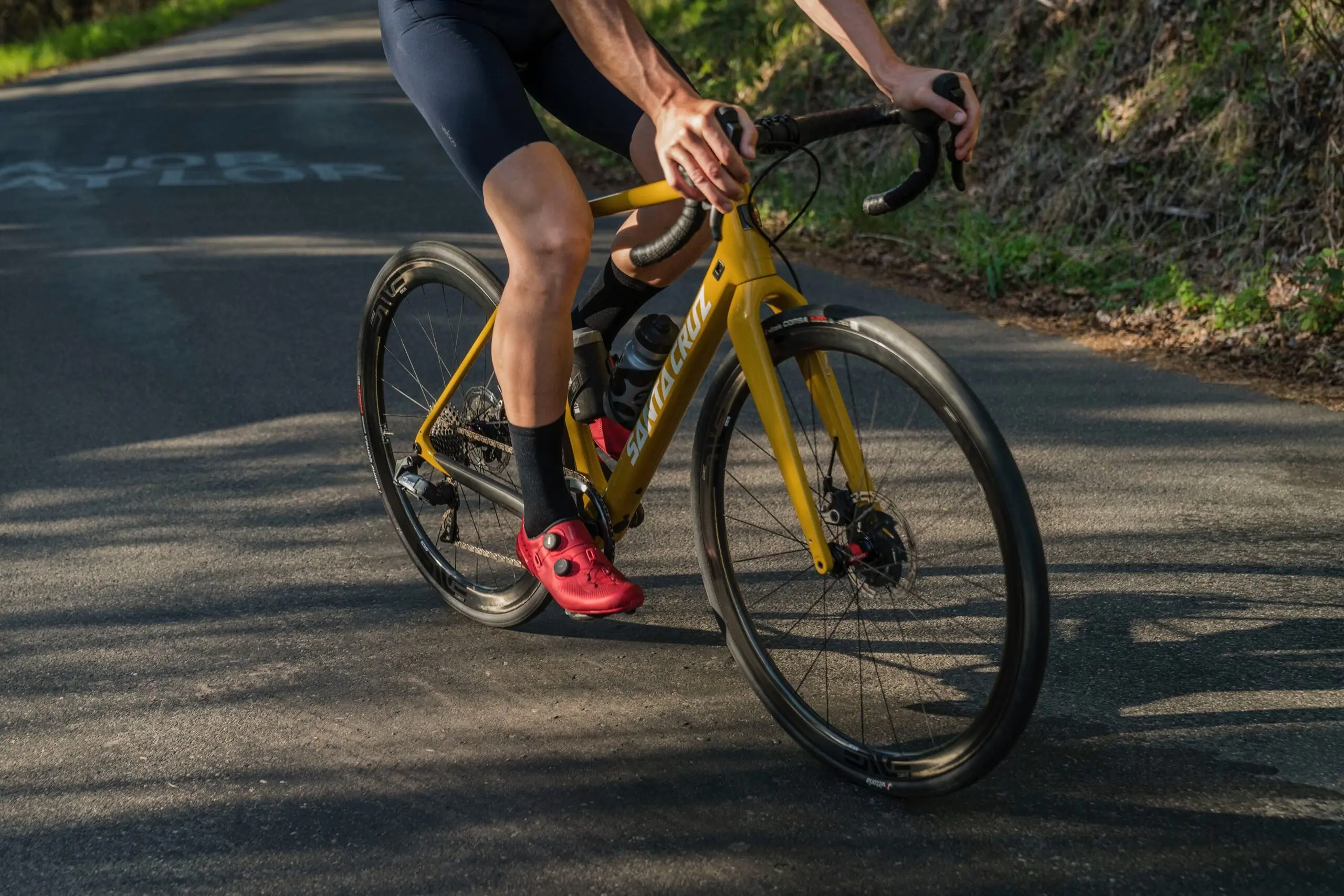

The Best Road Bike Shoes of 2024
We tested 14 of the best road bike shoes on the market to help you find the right pair for your needs and budget.


